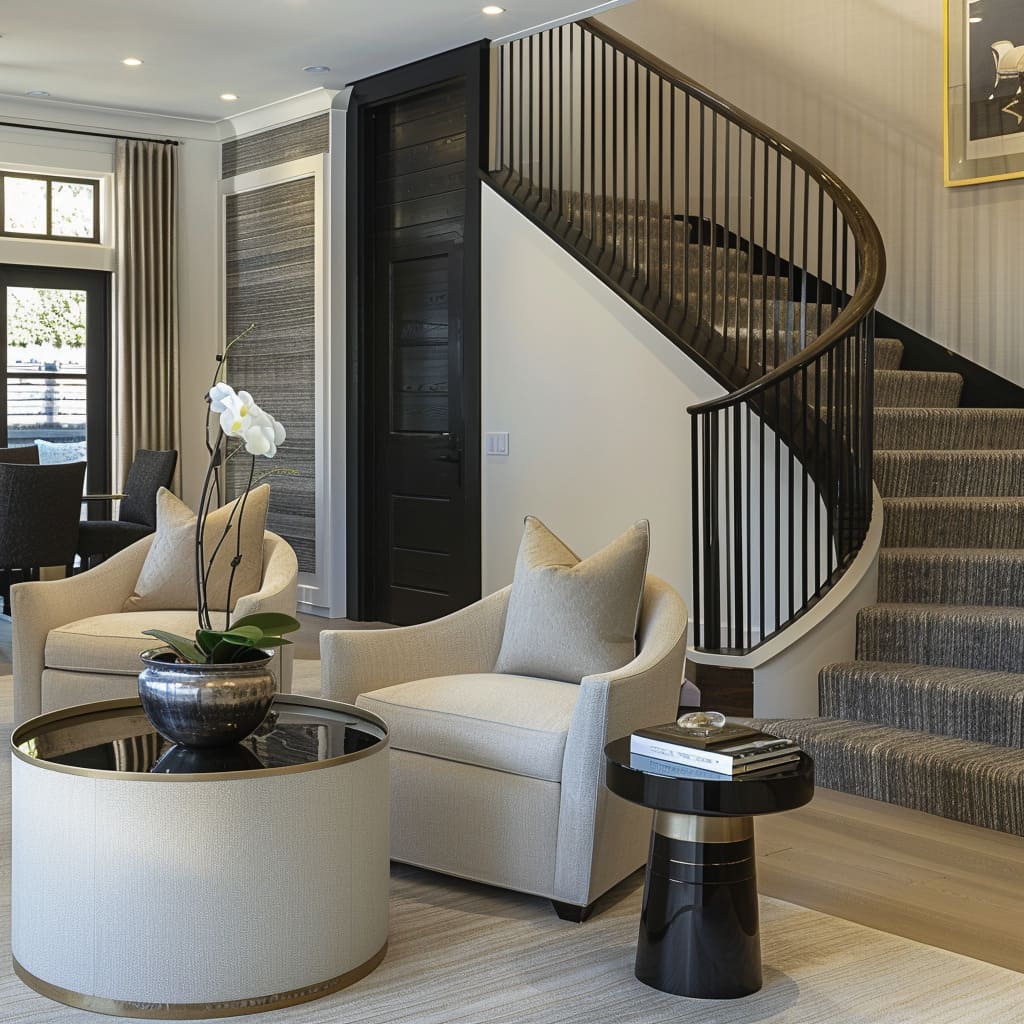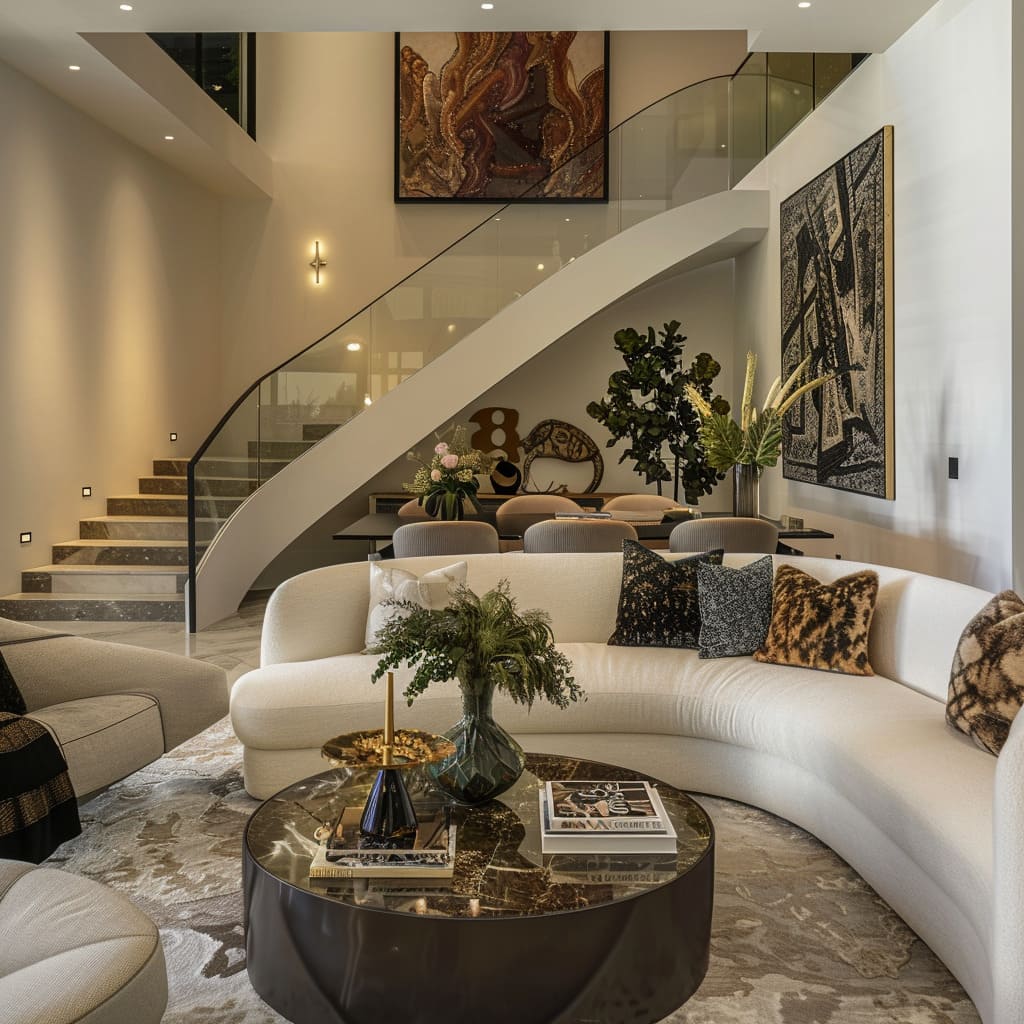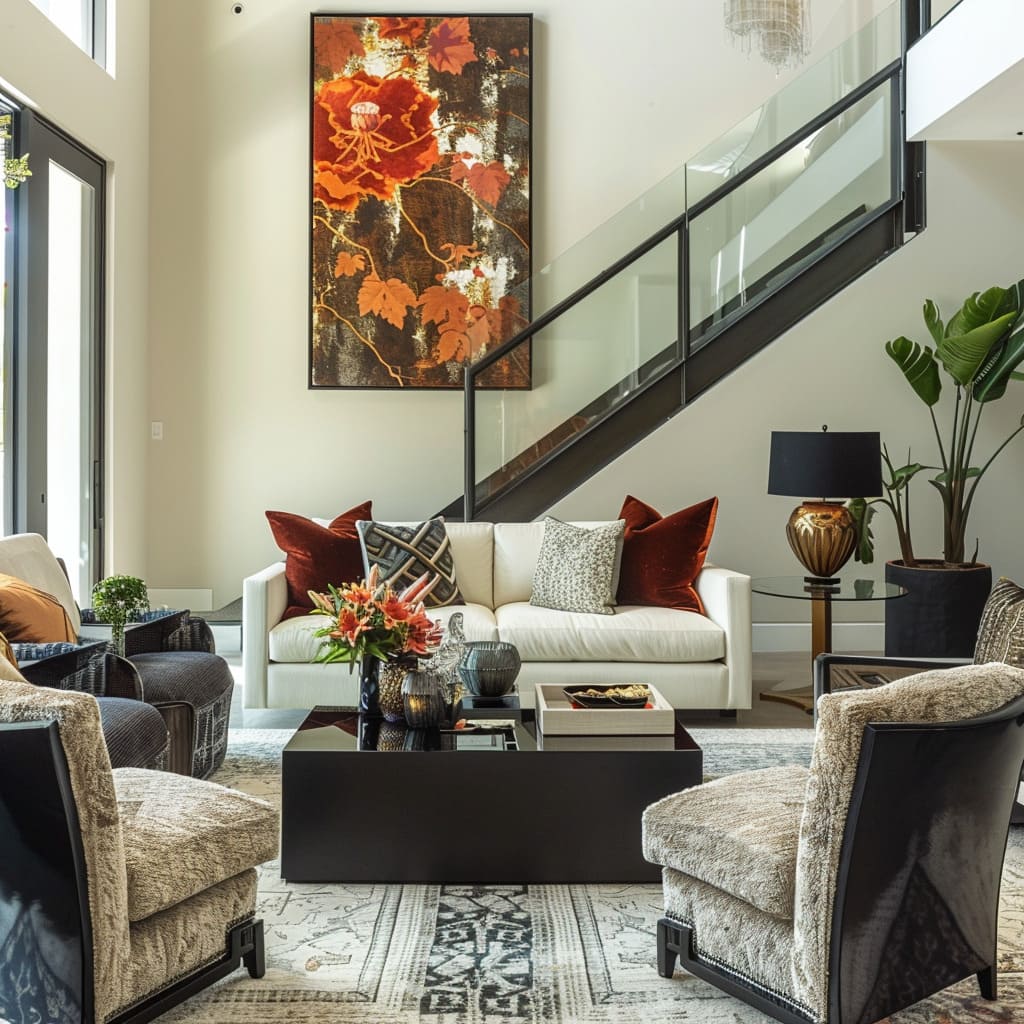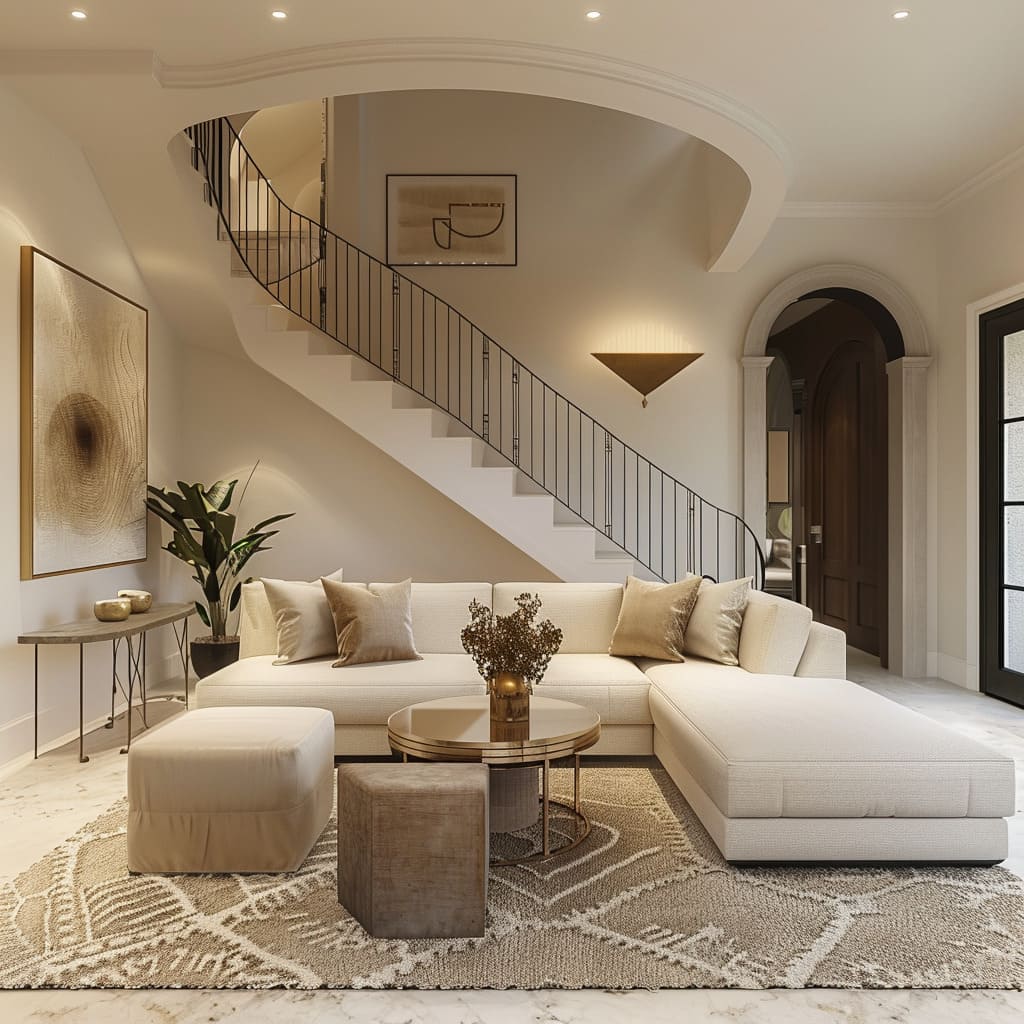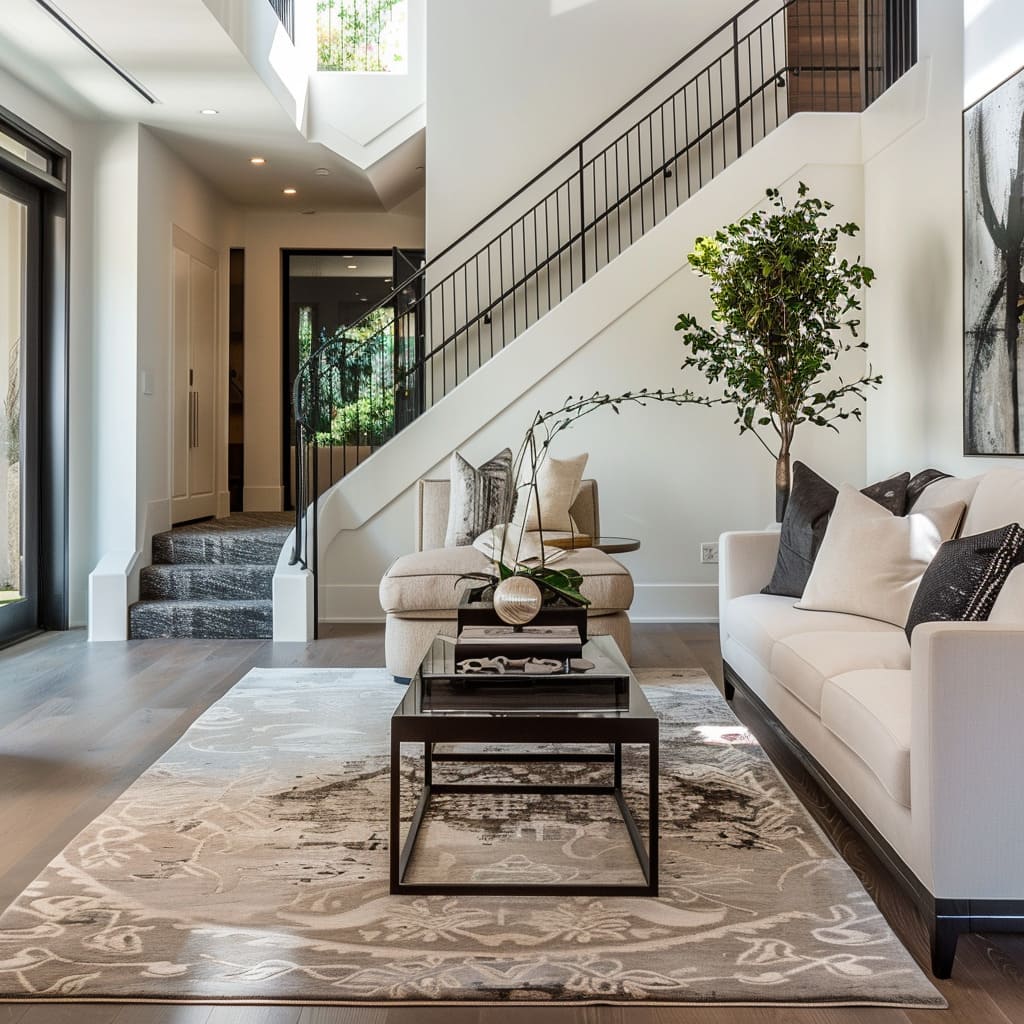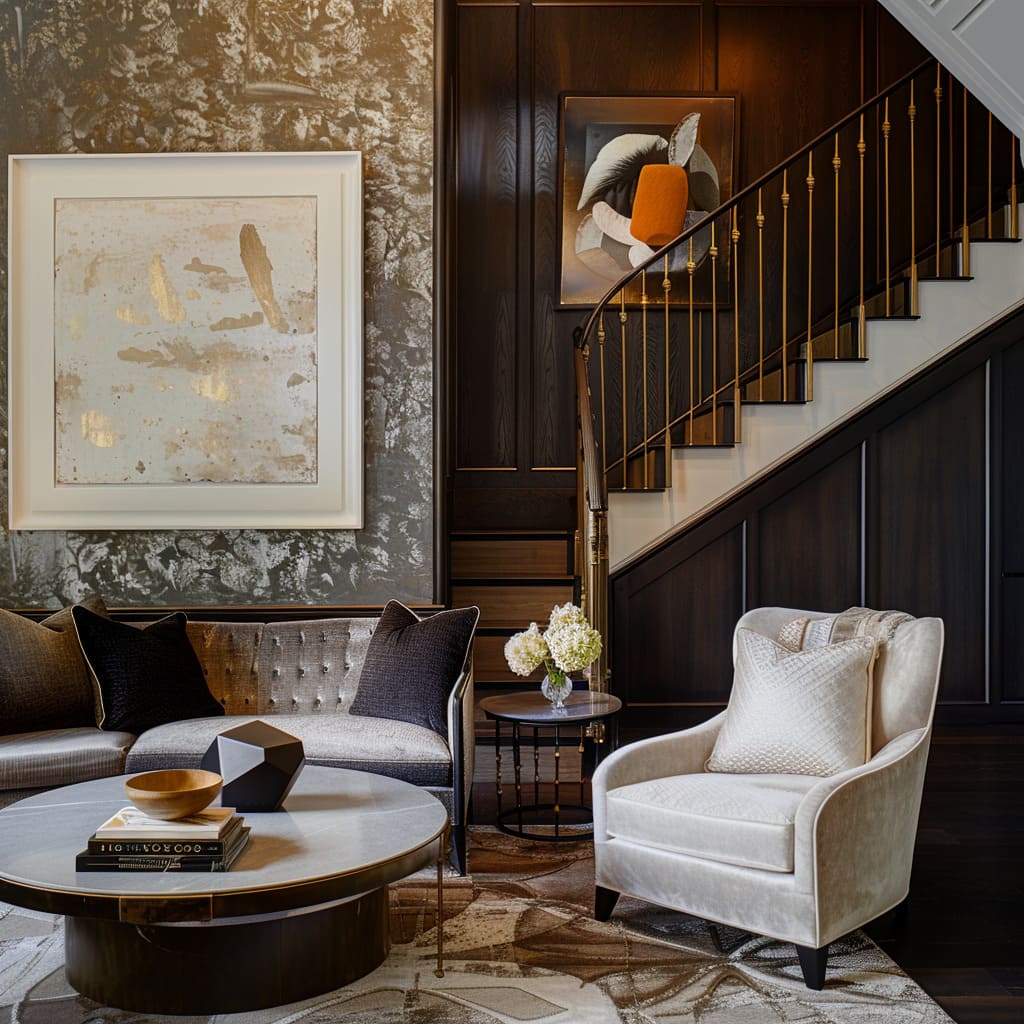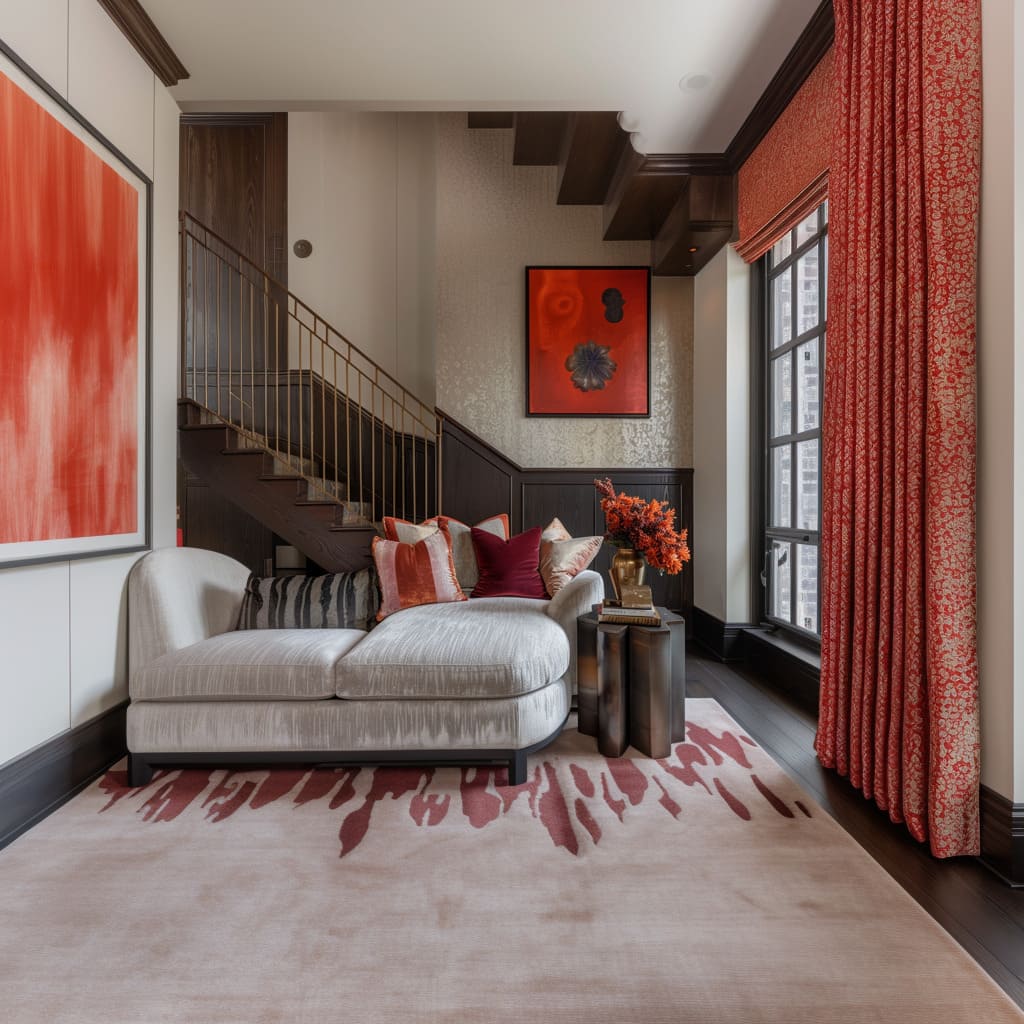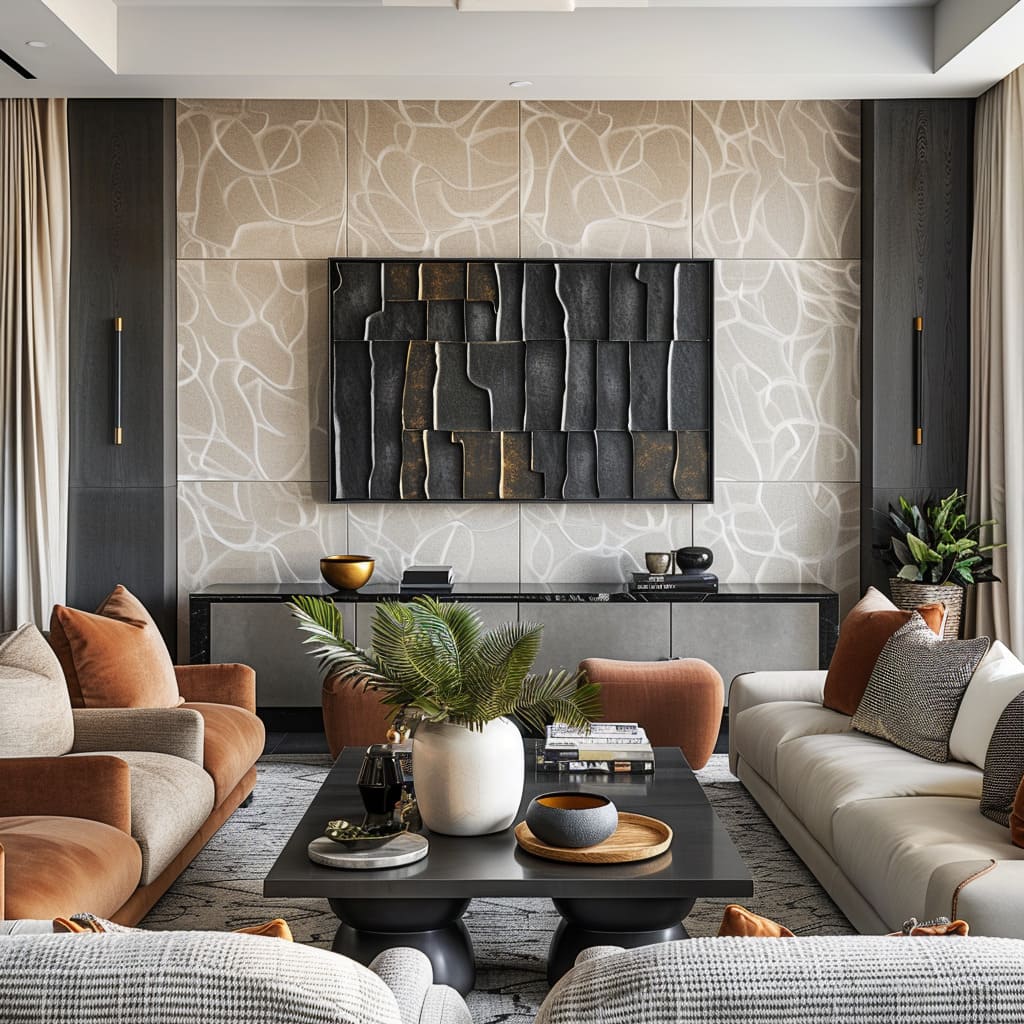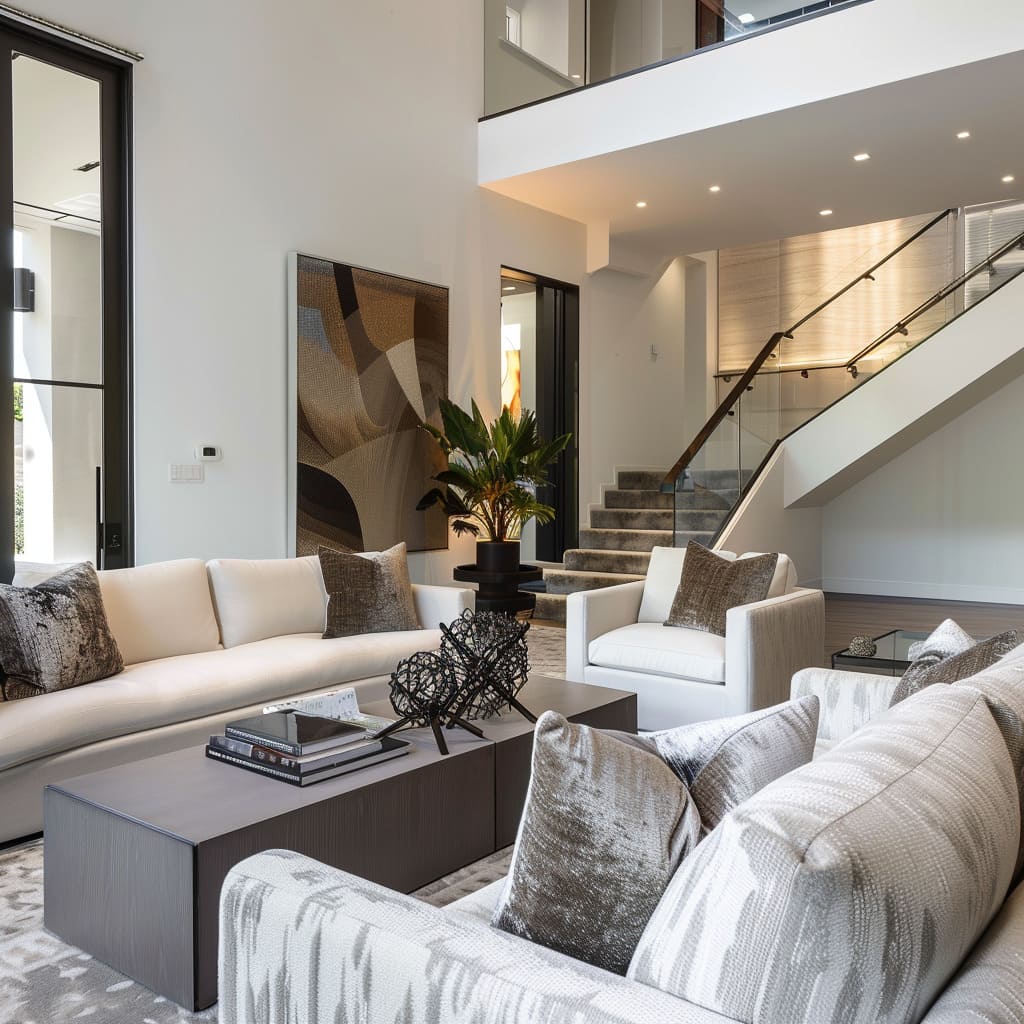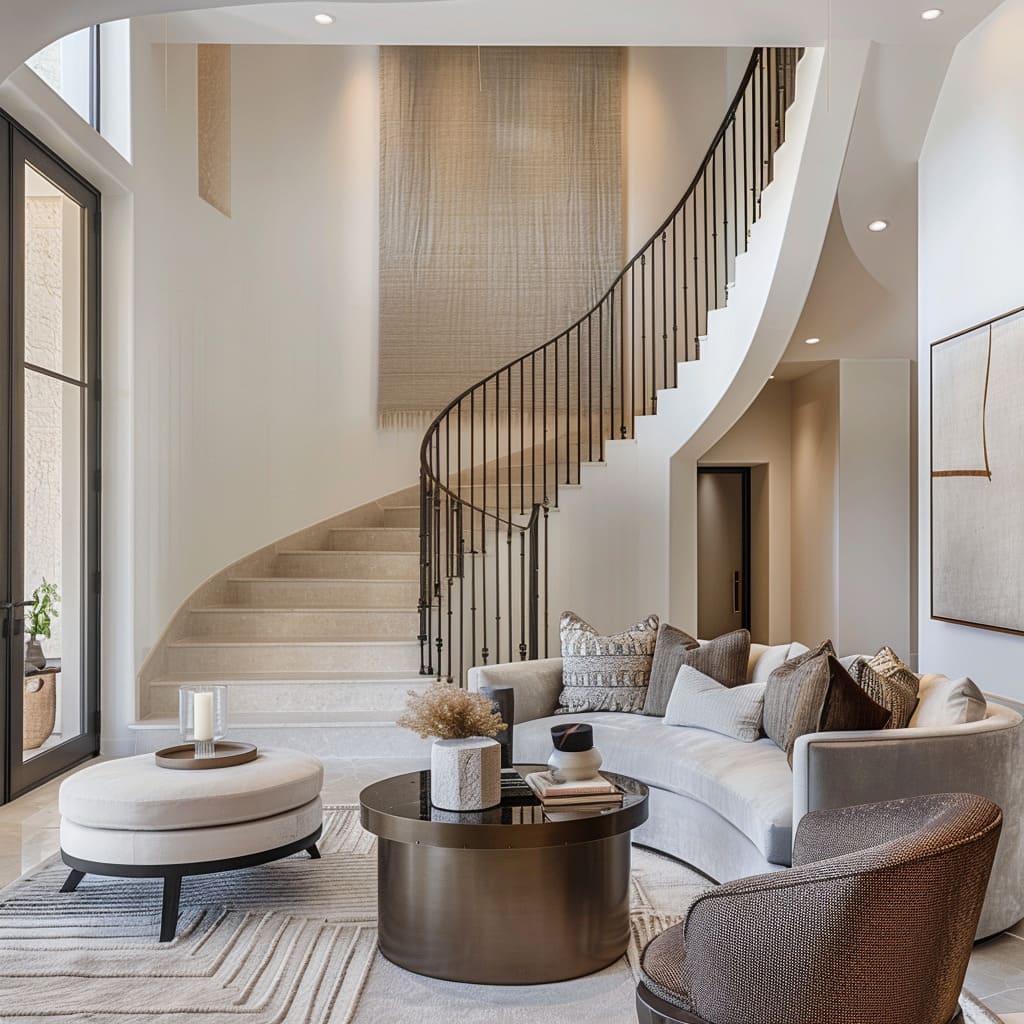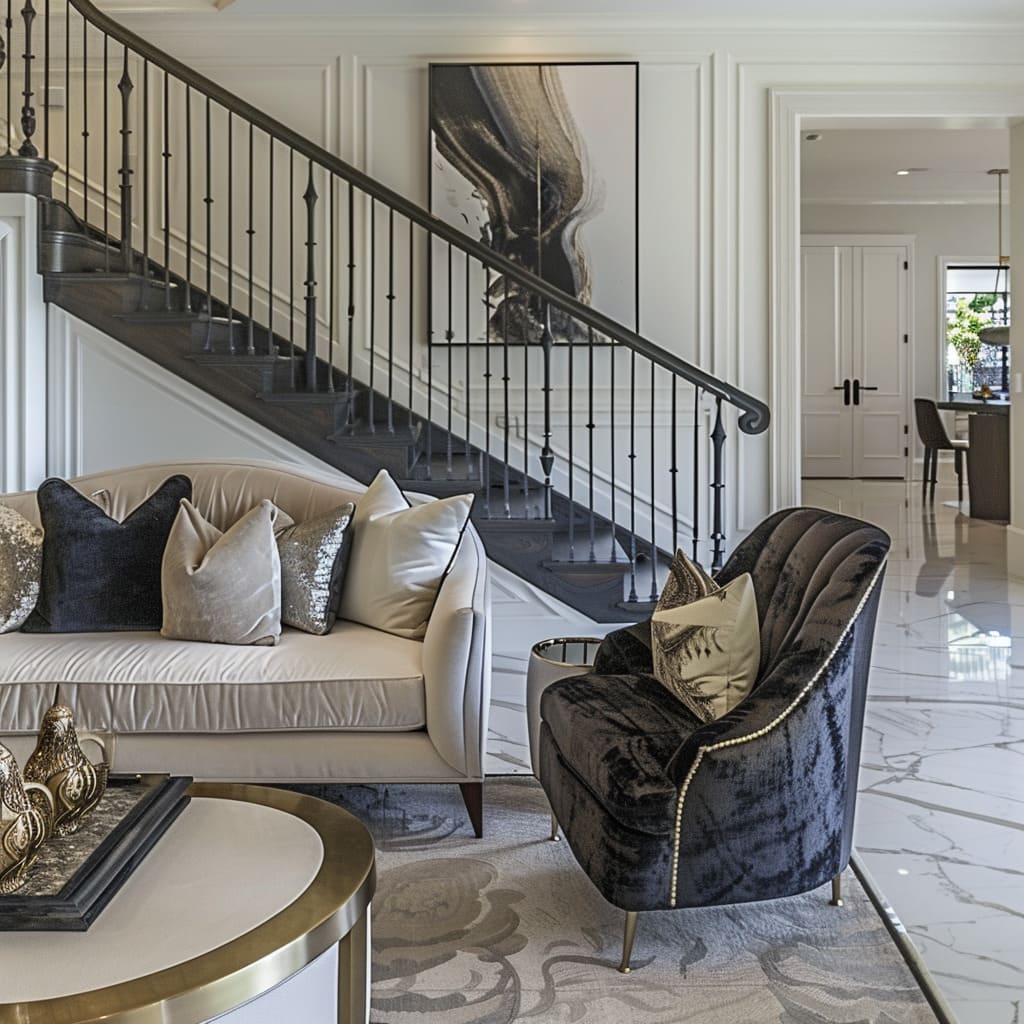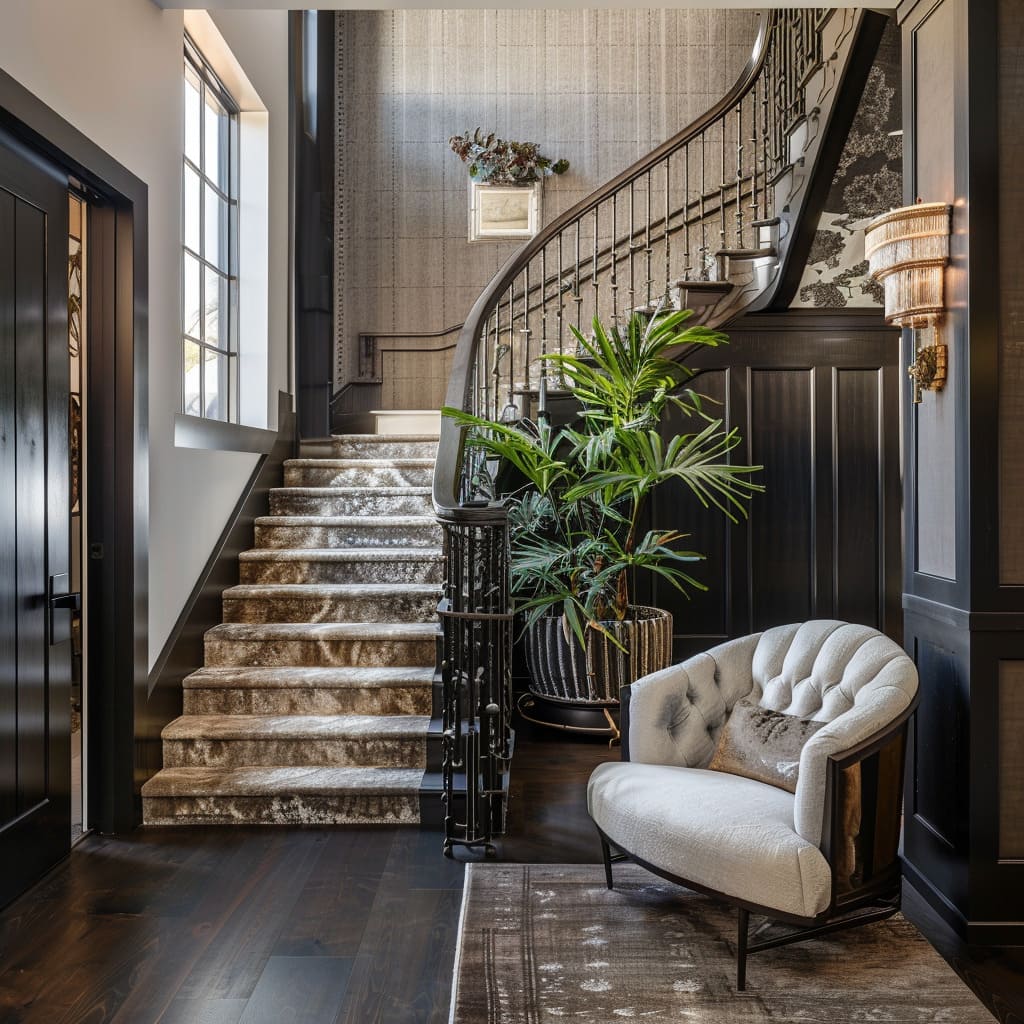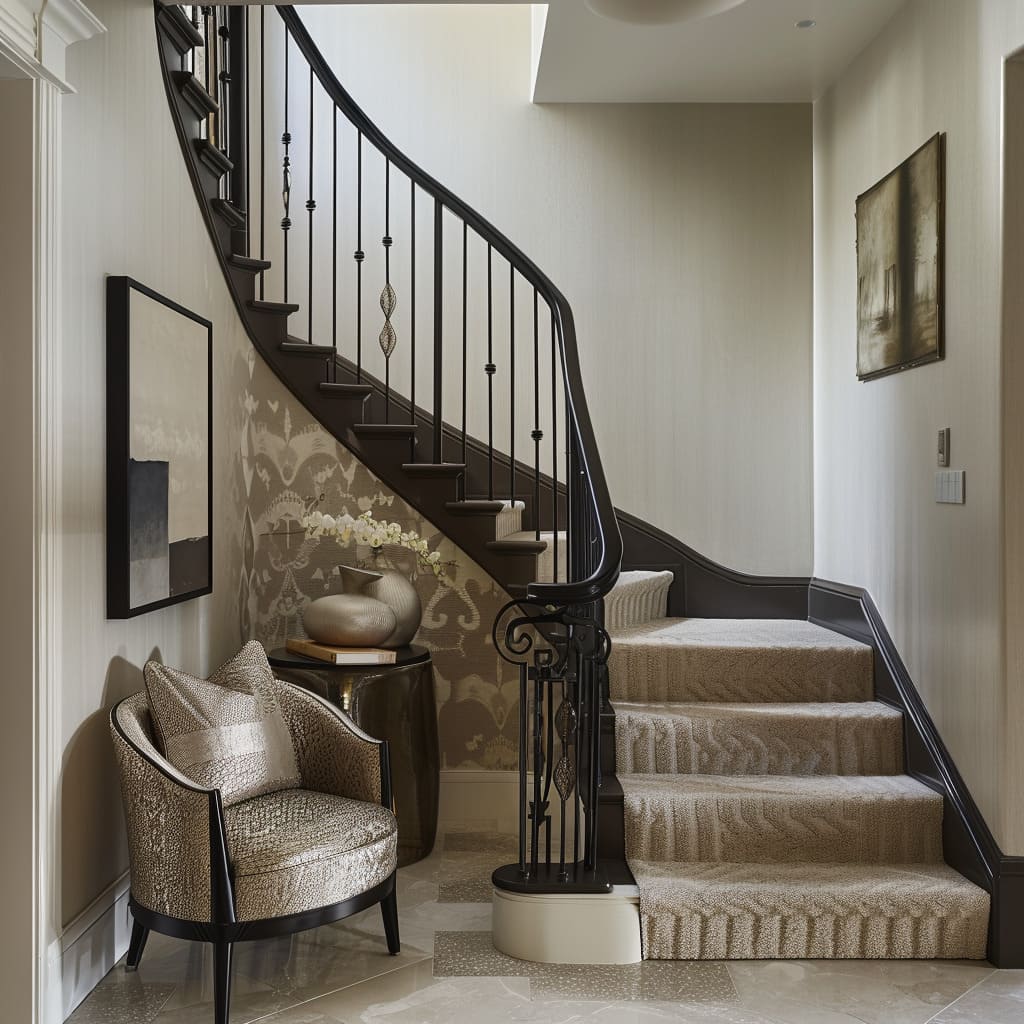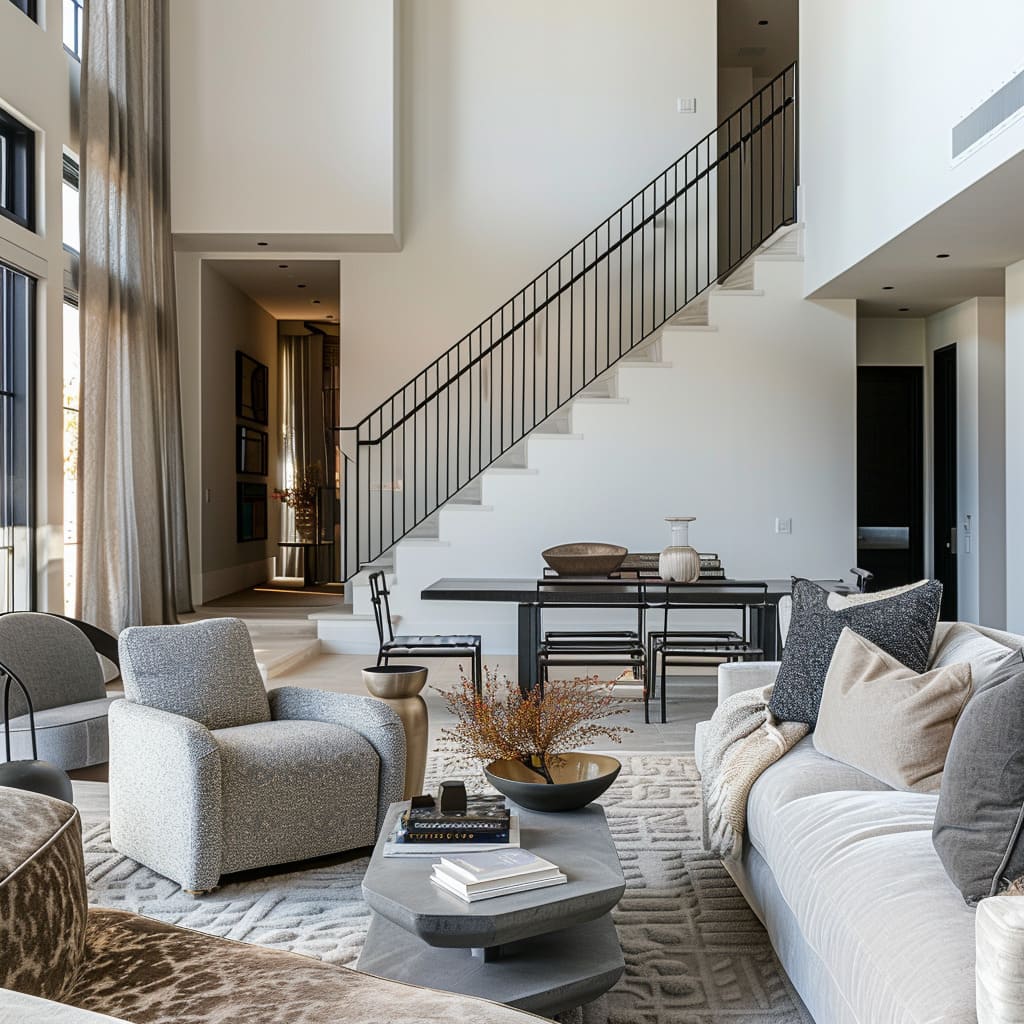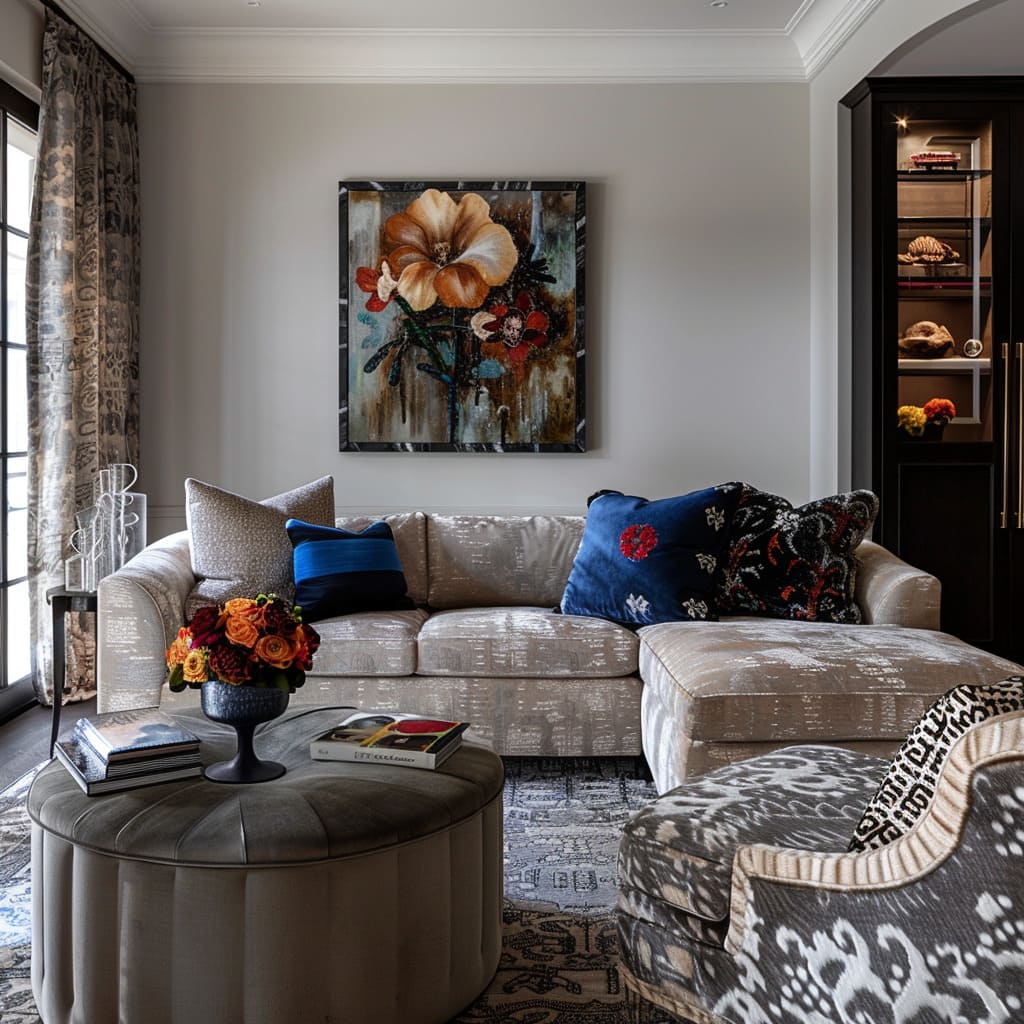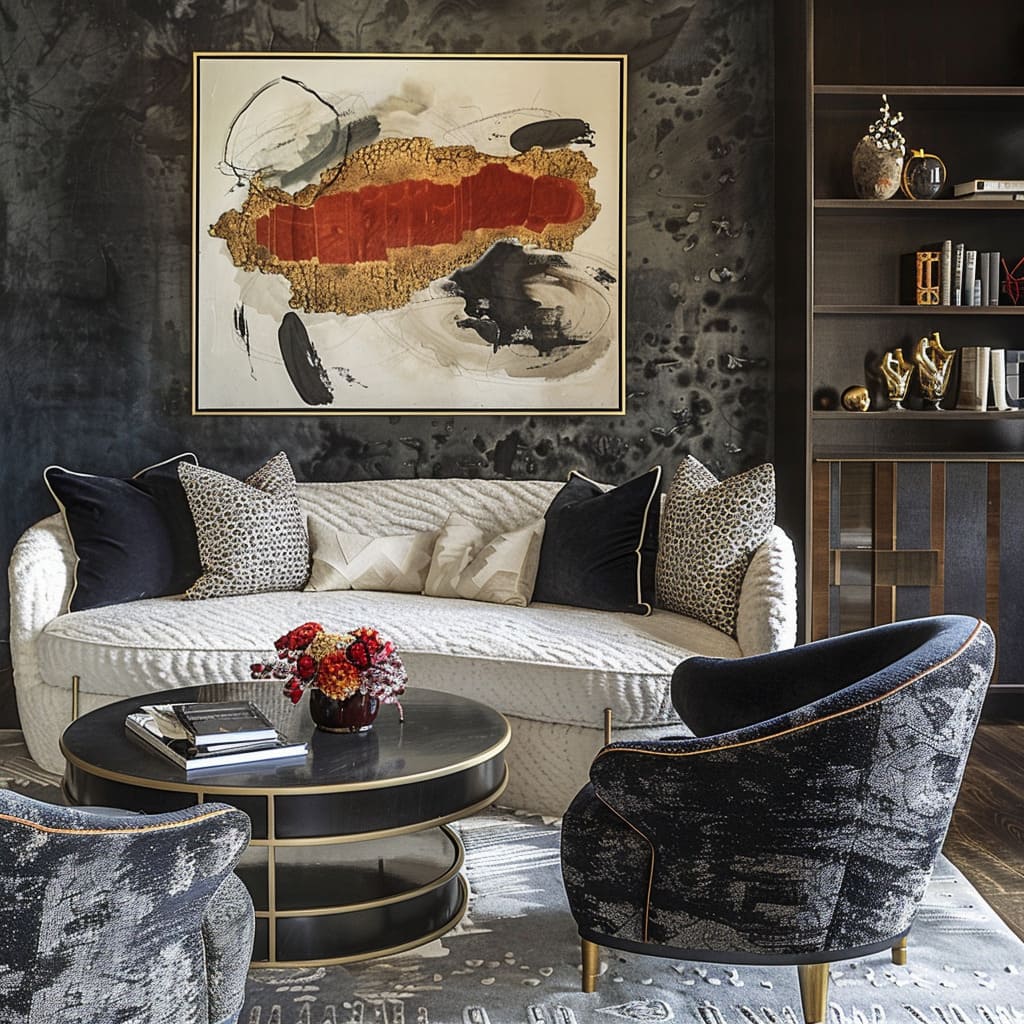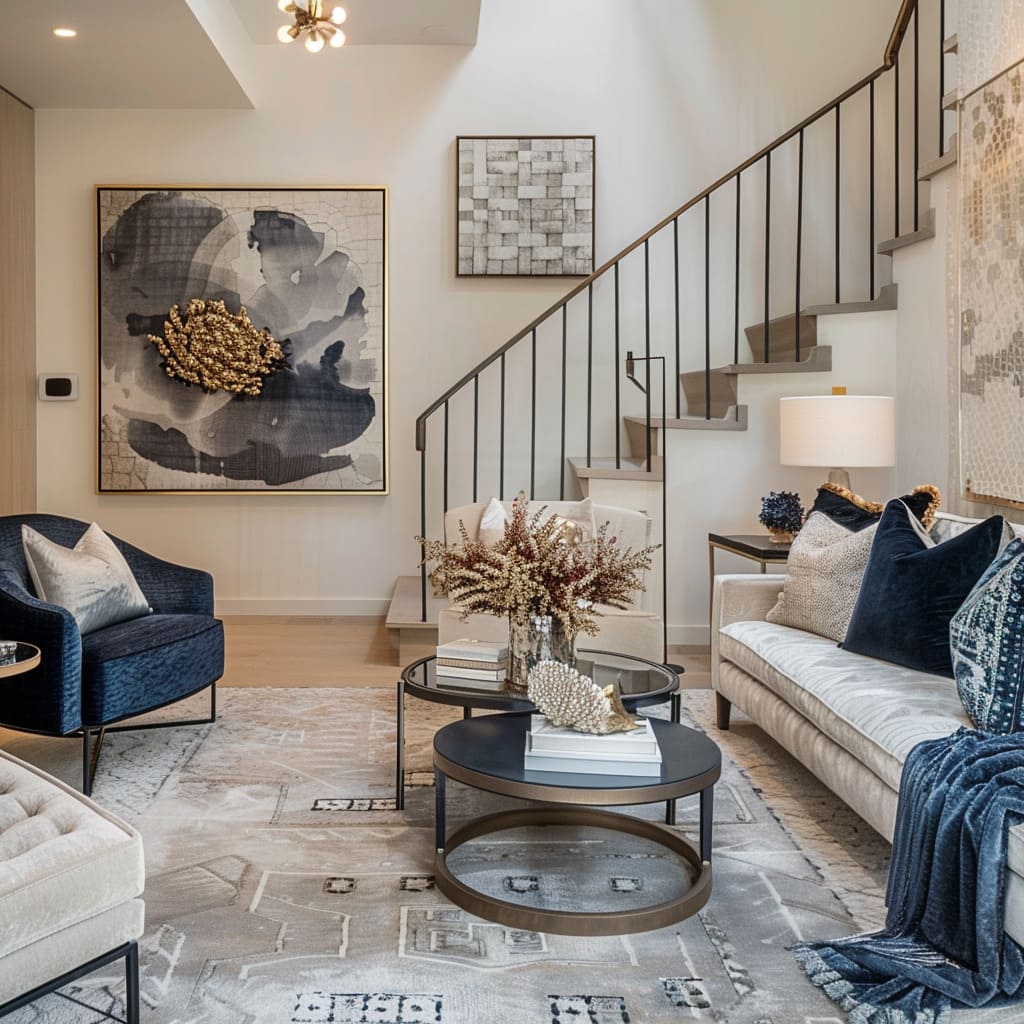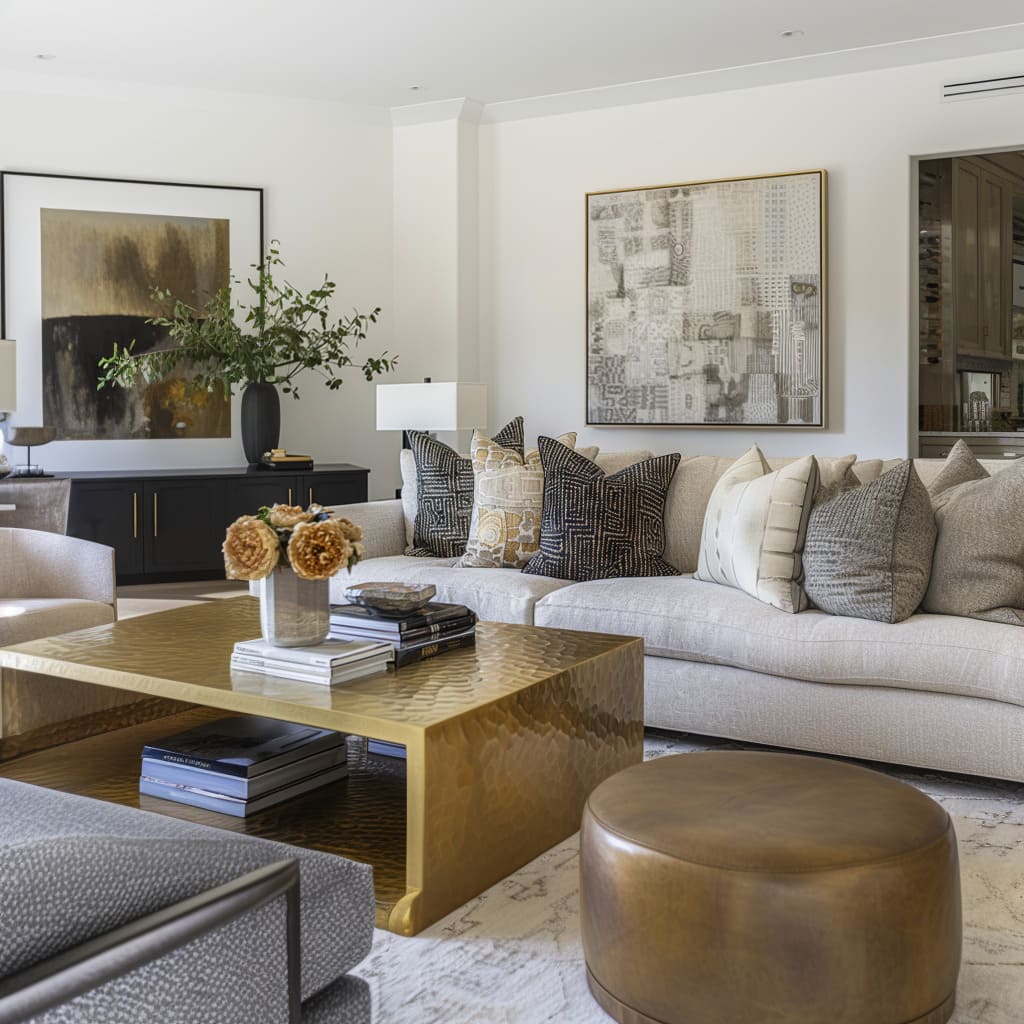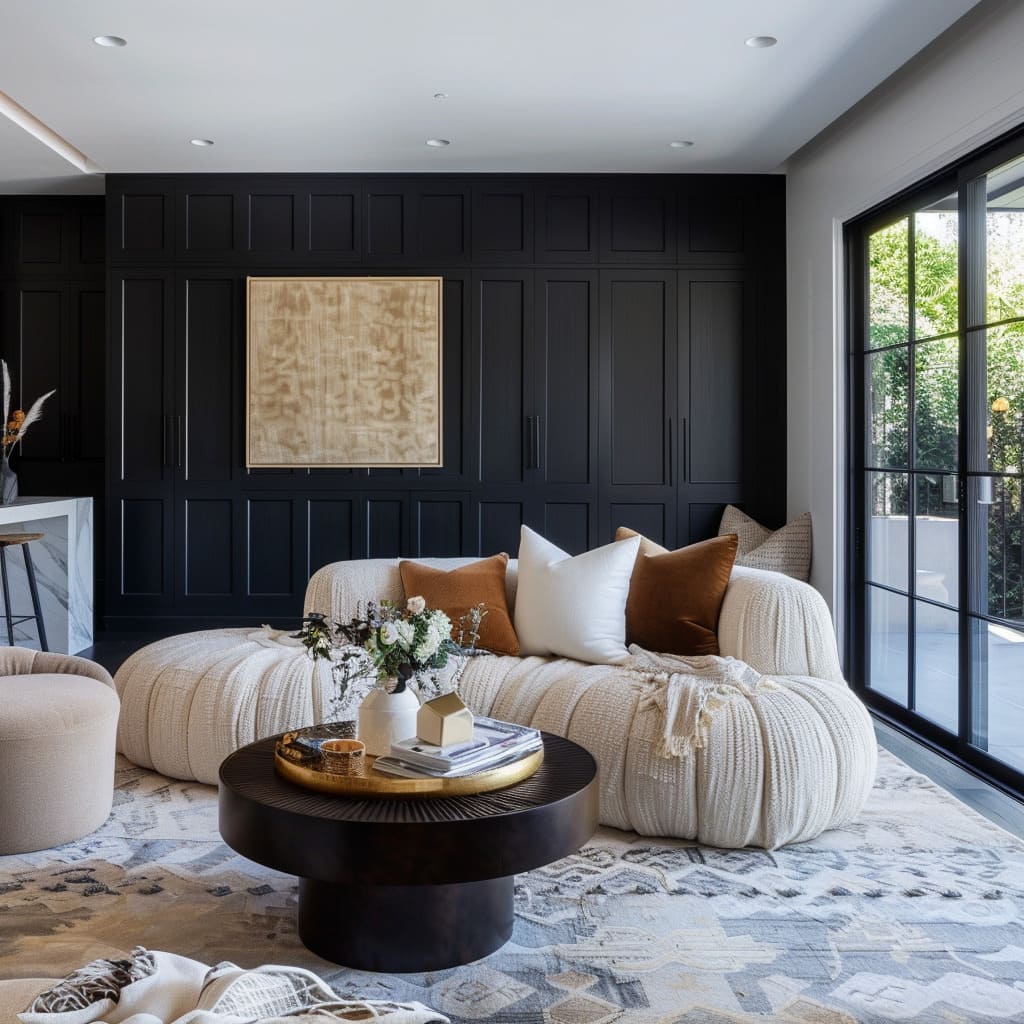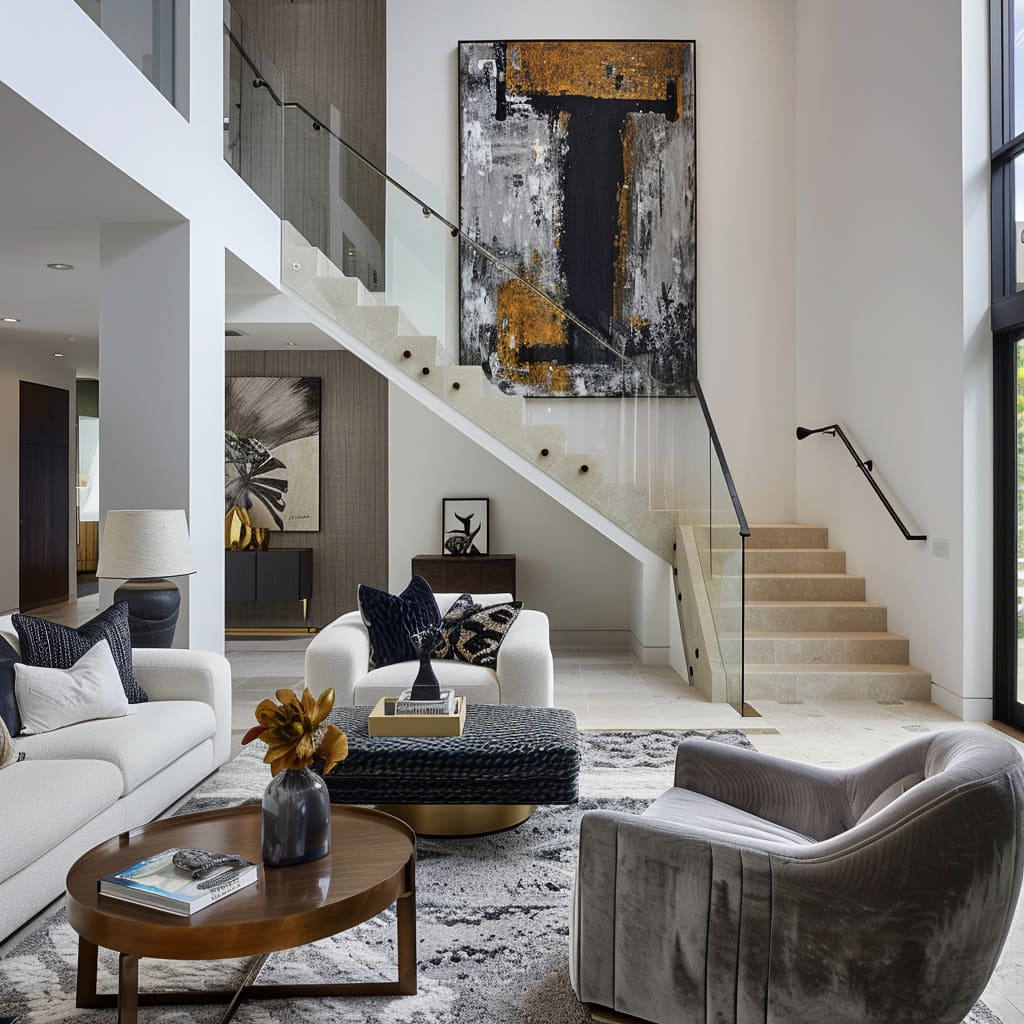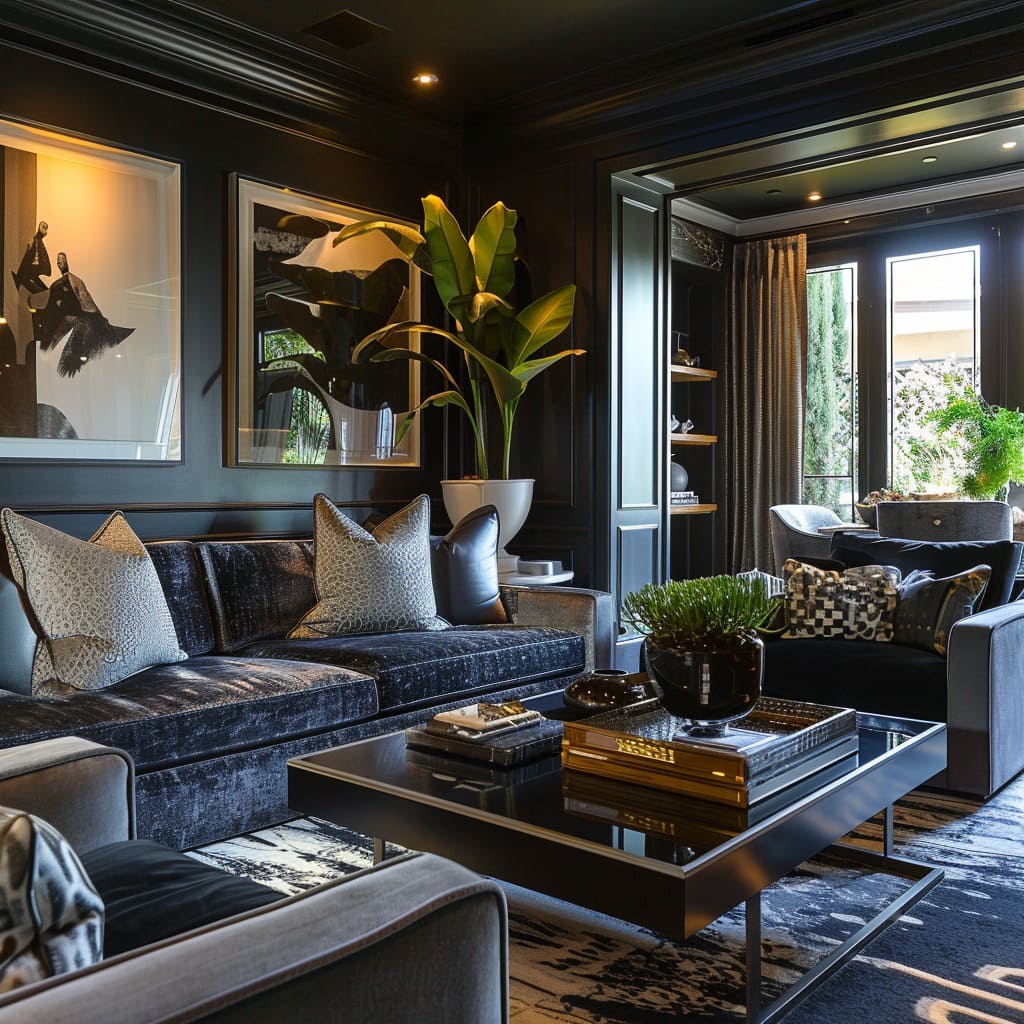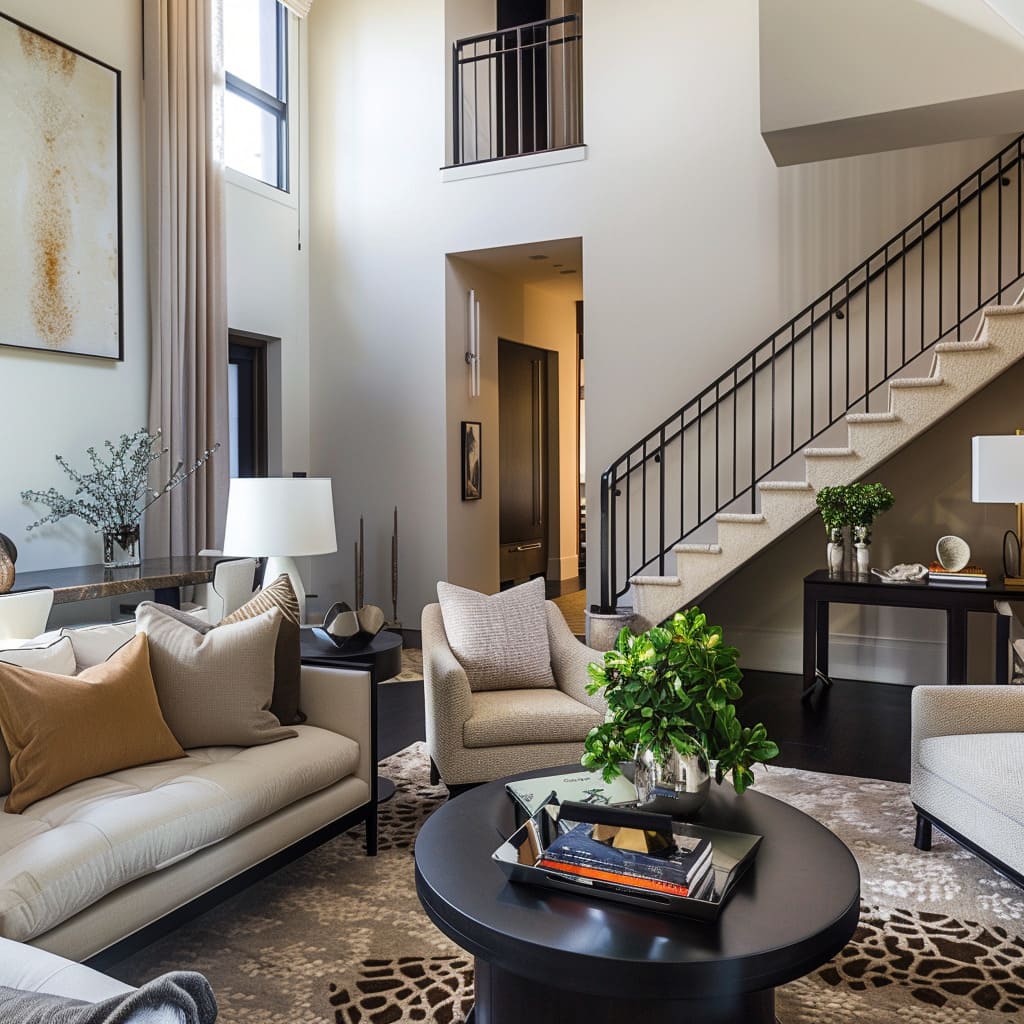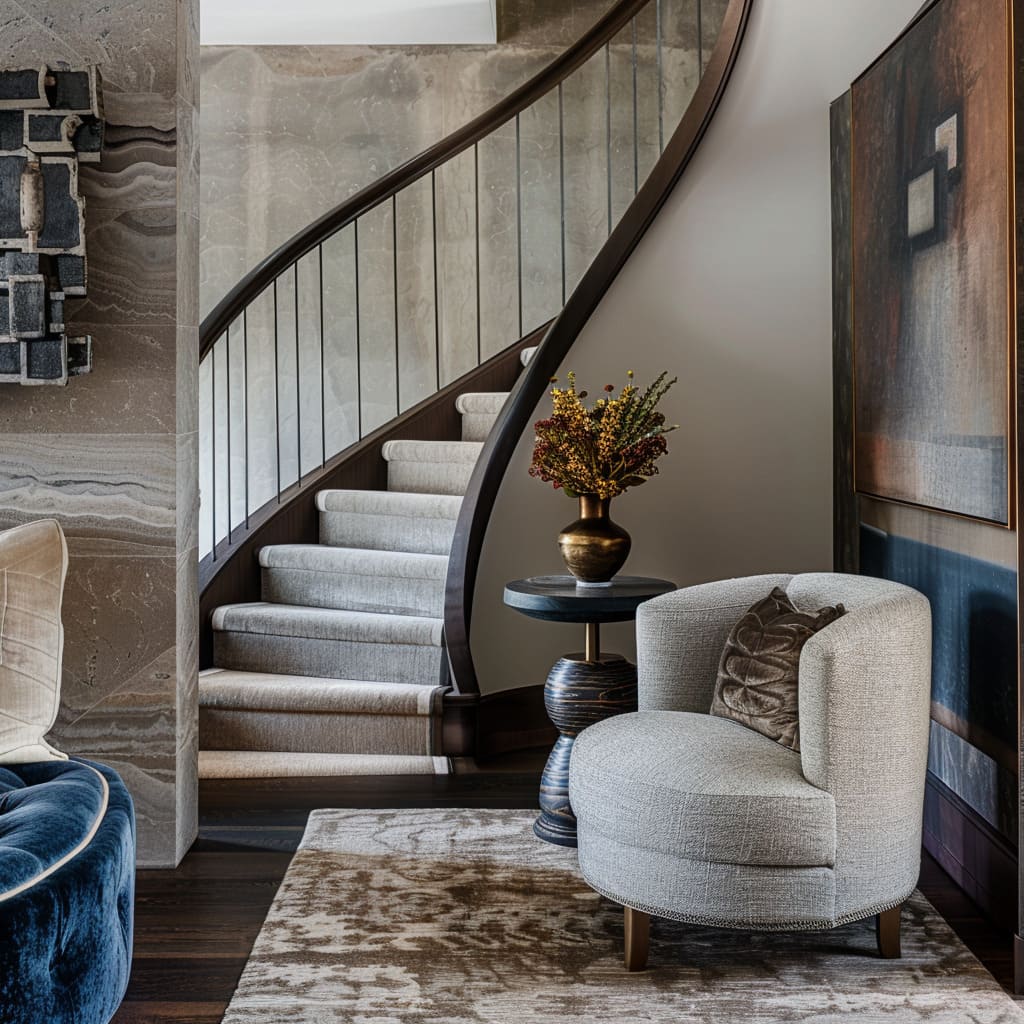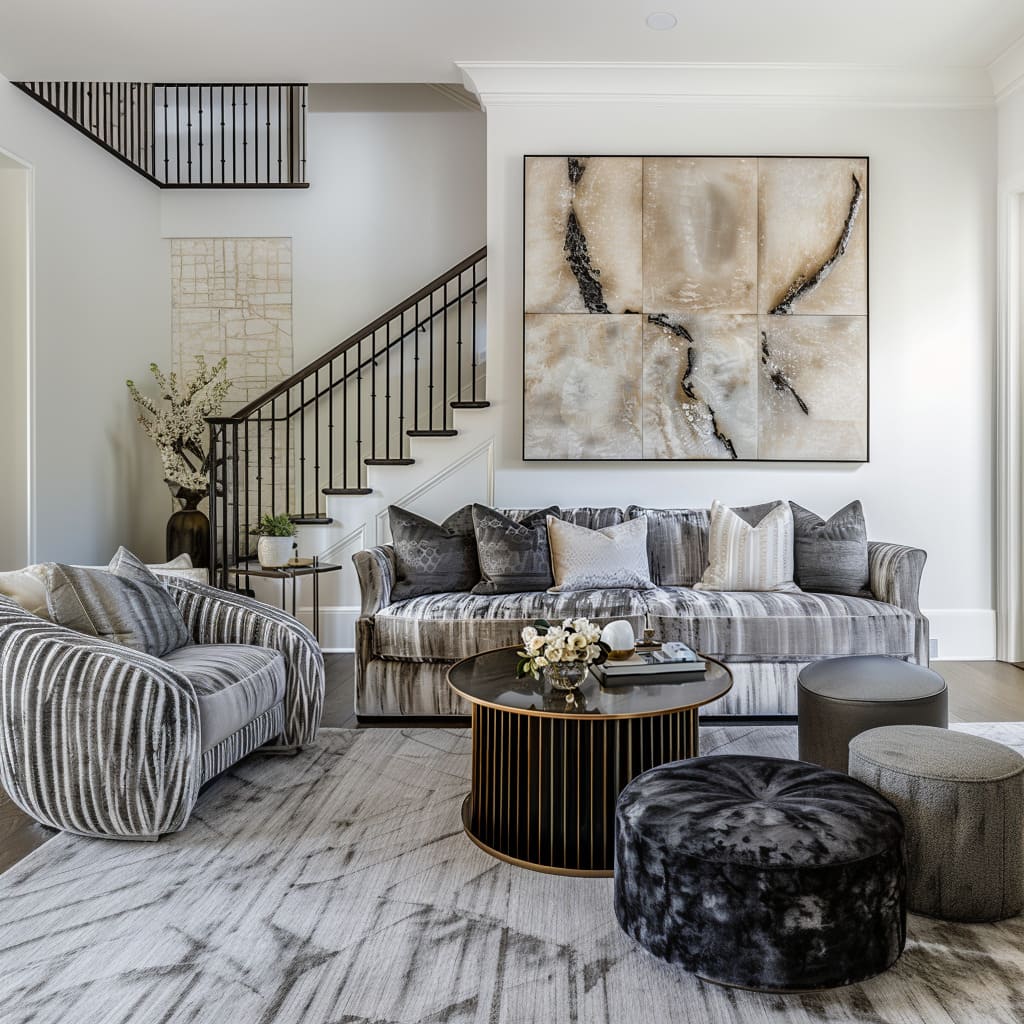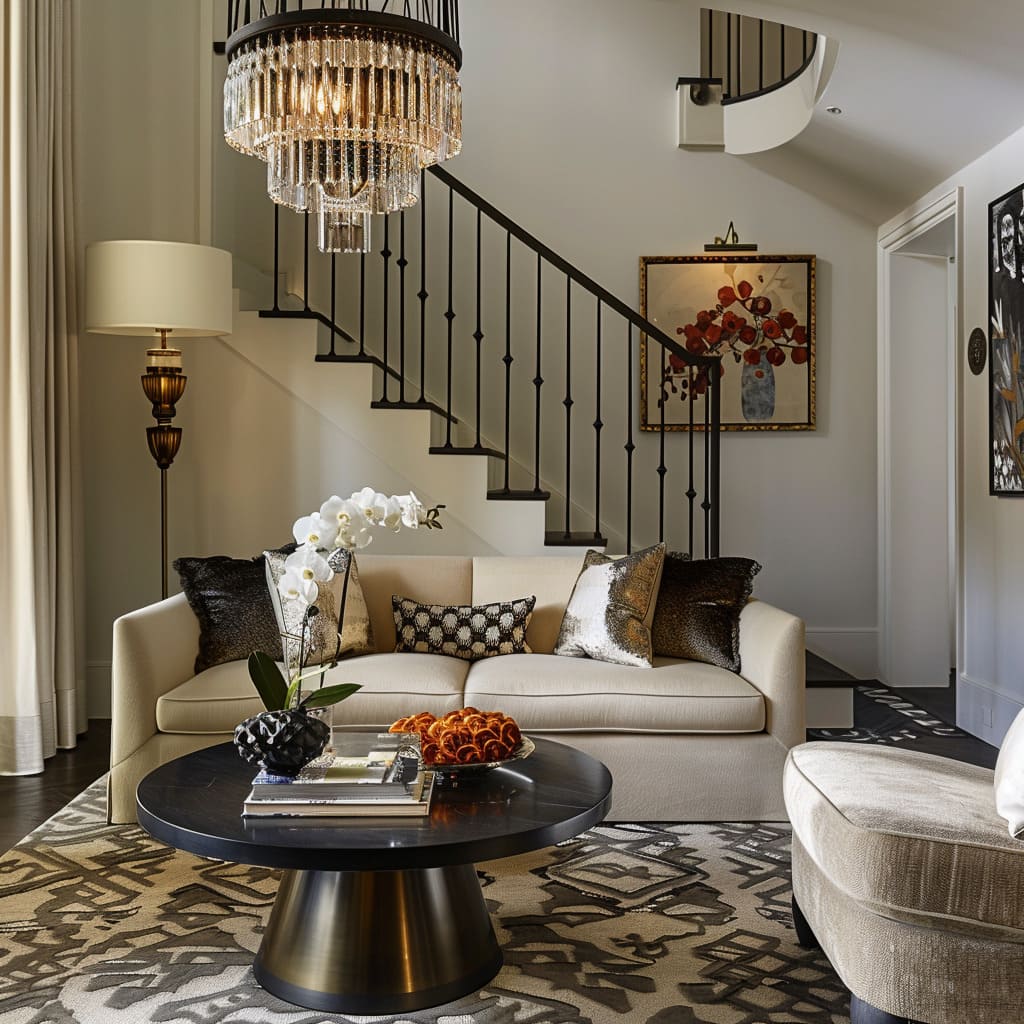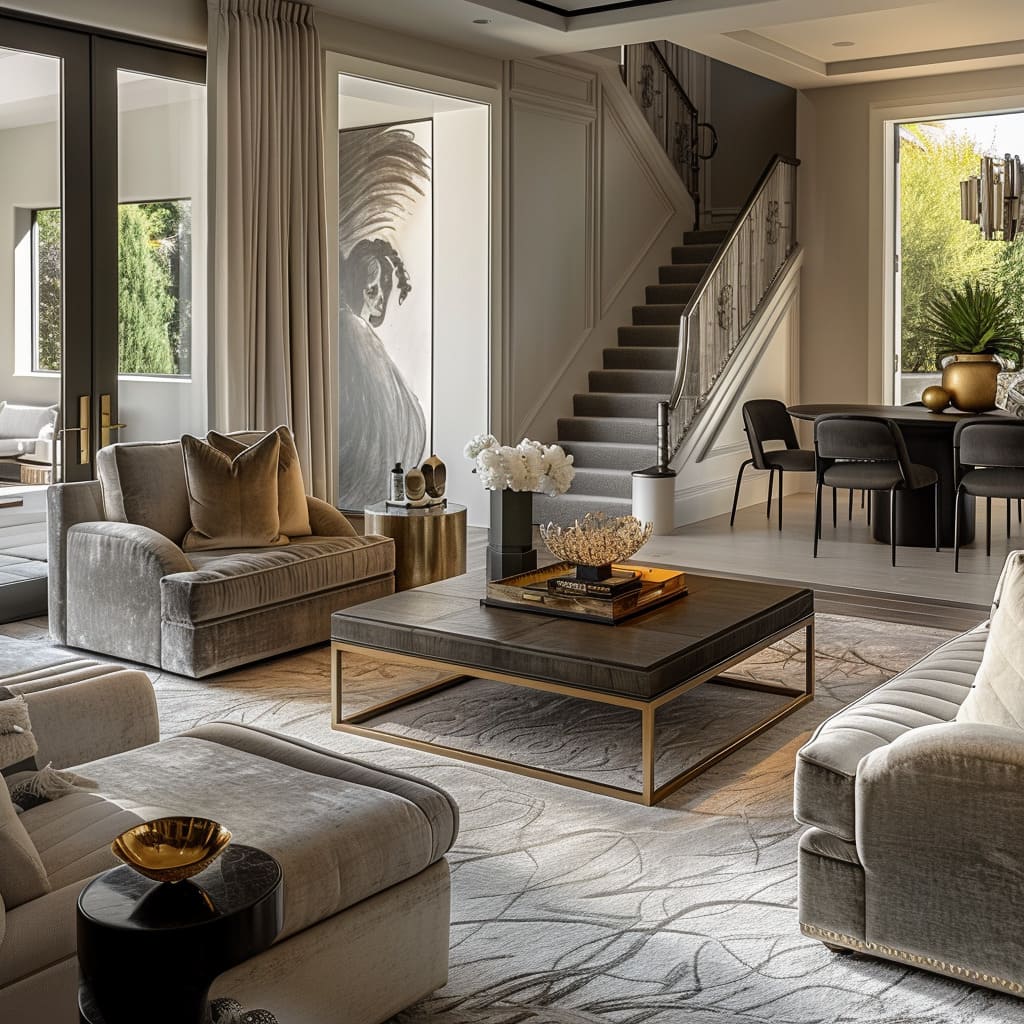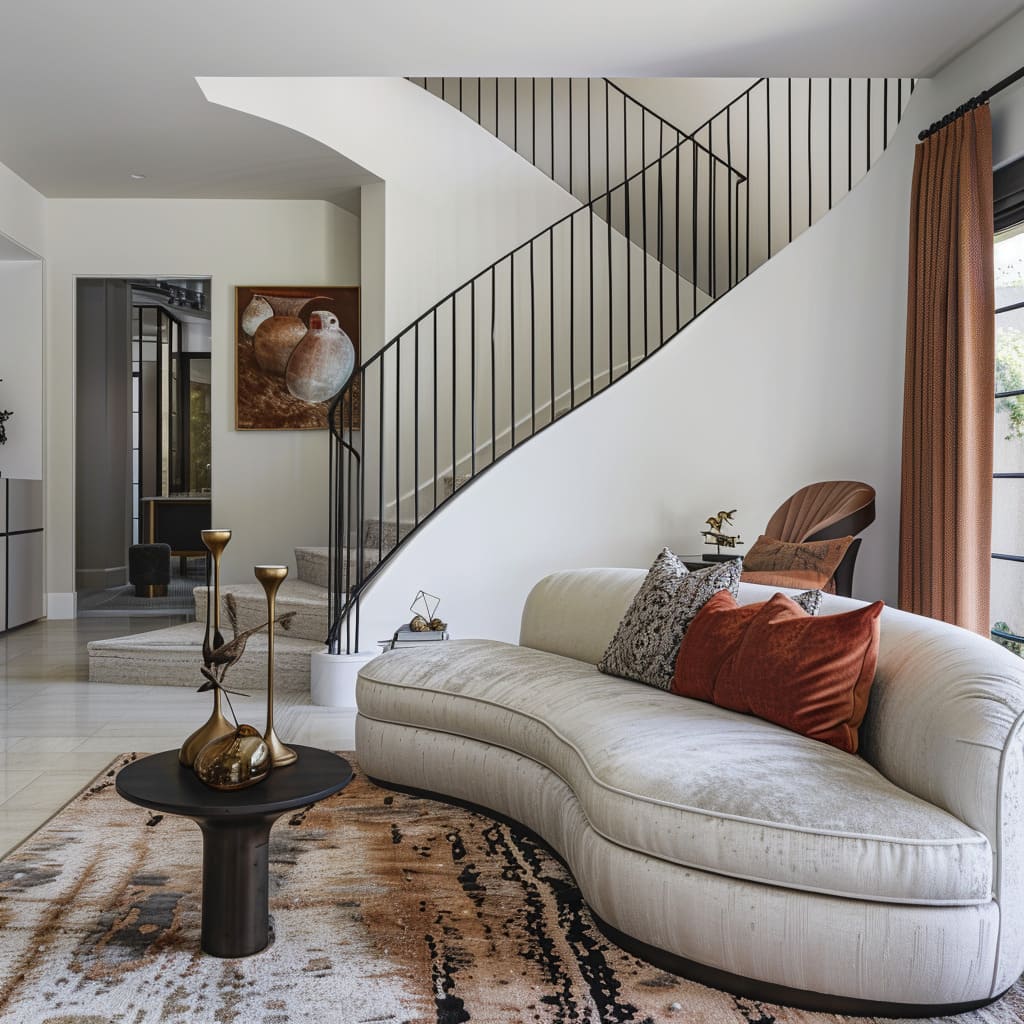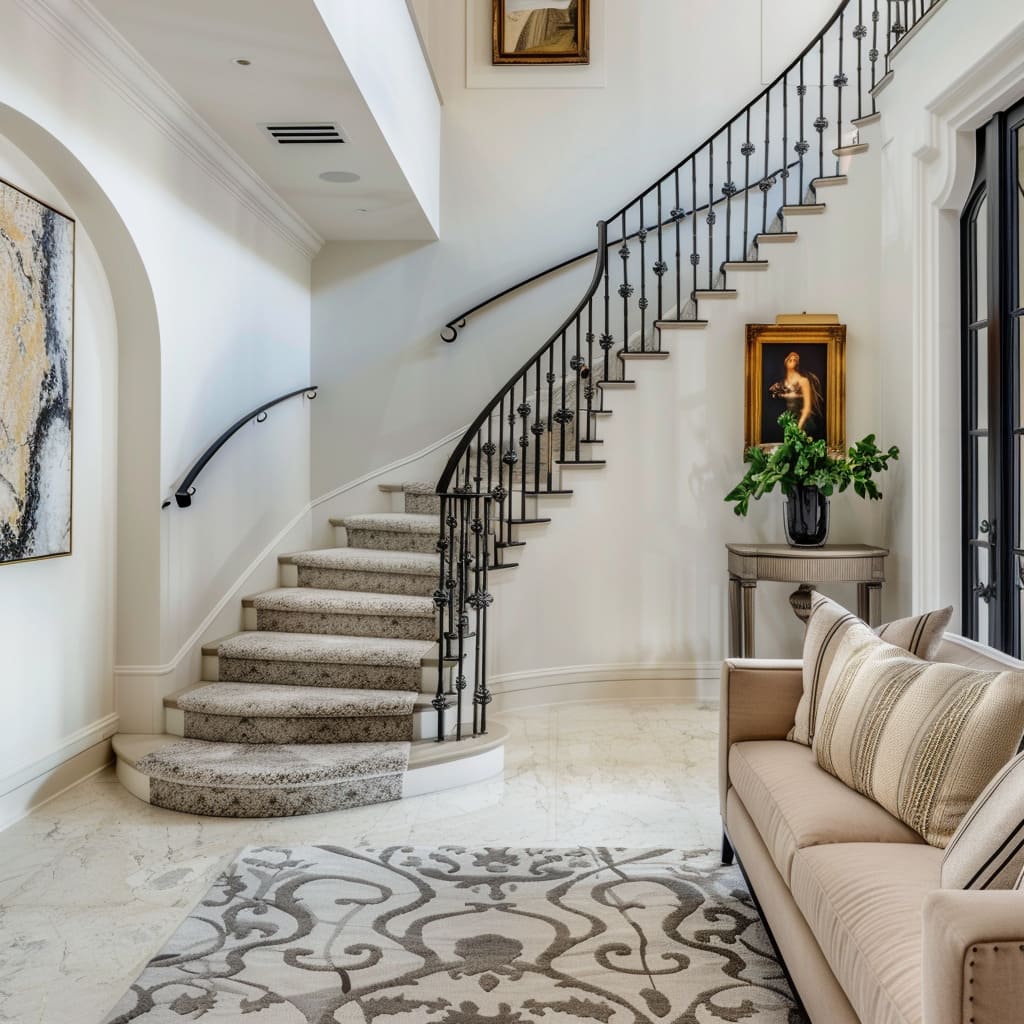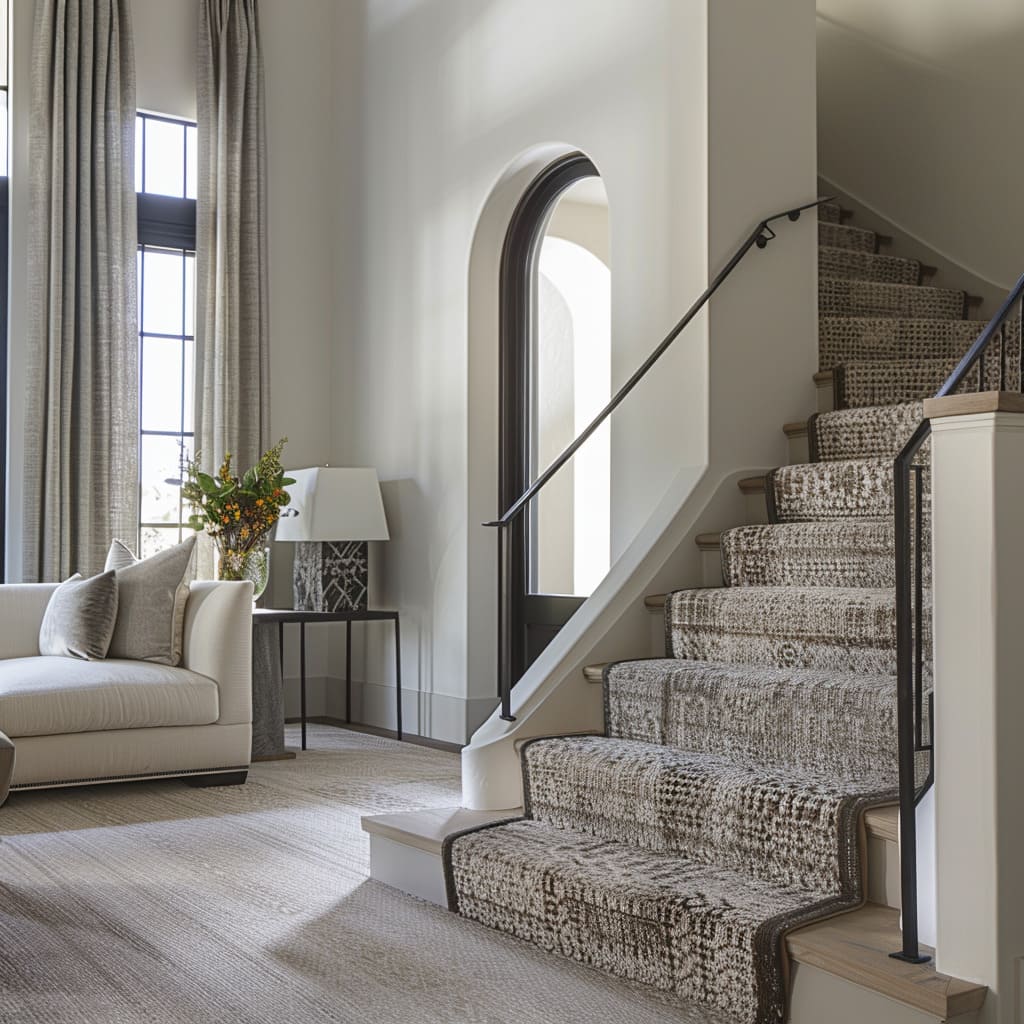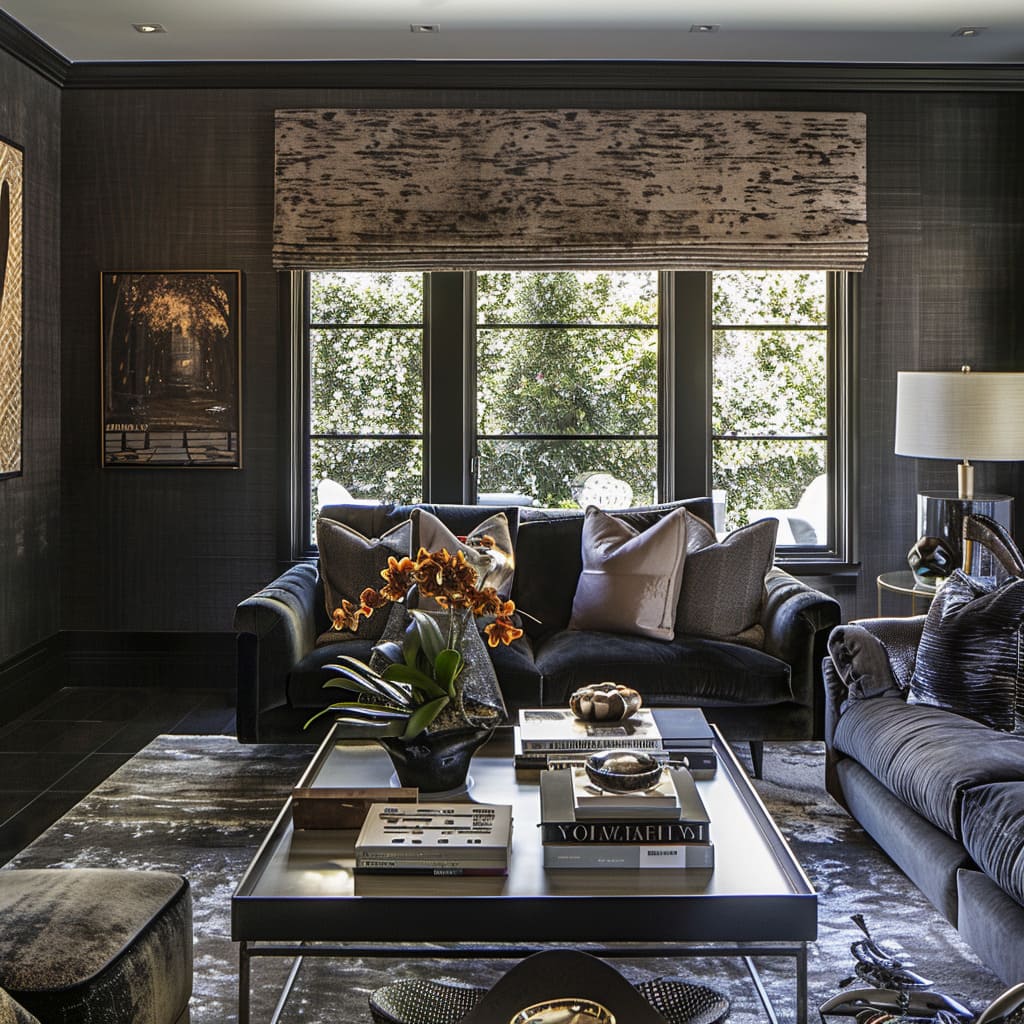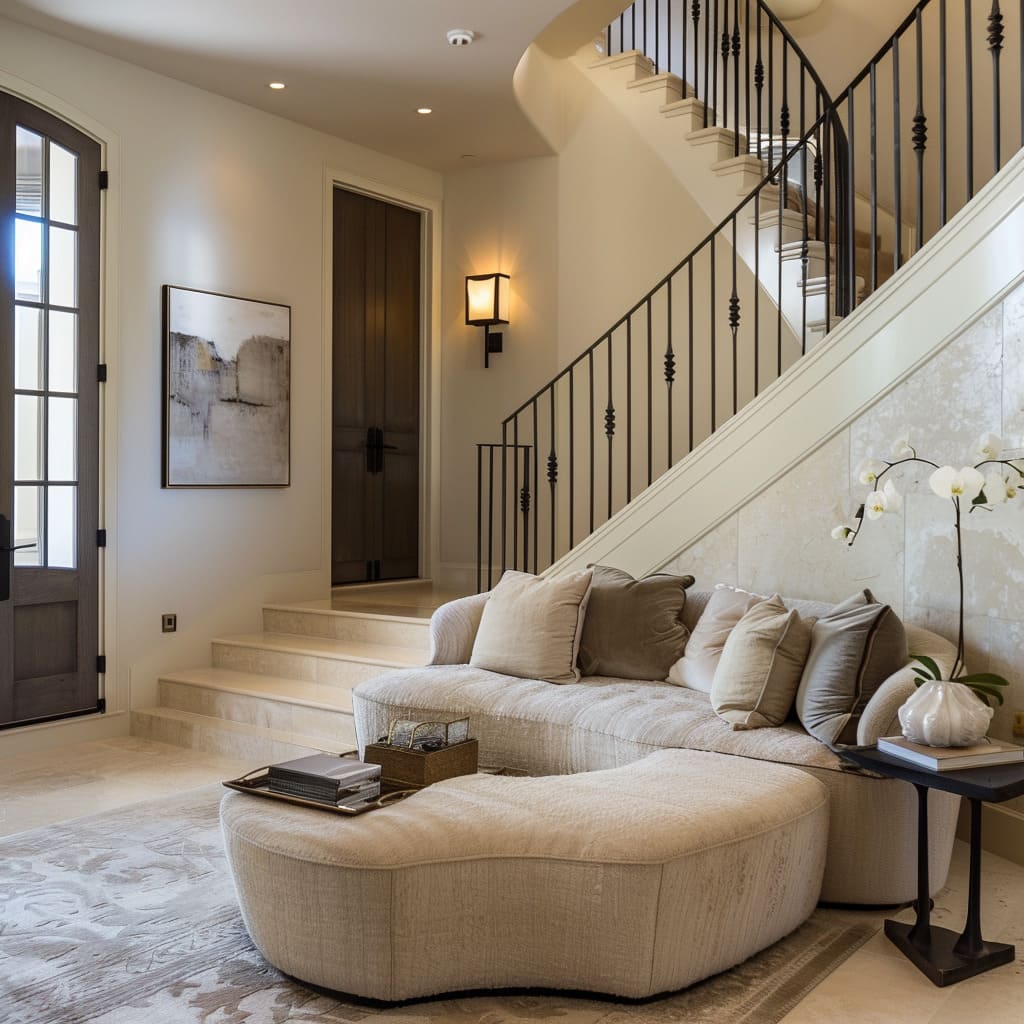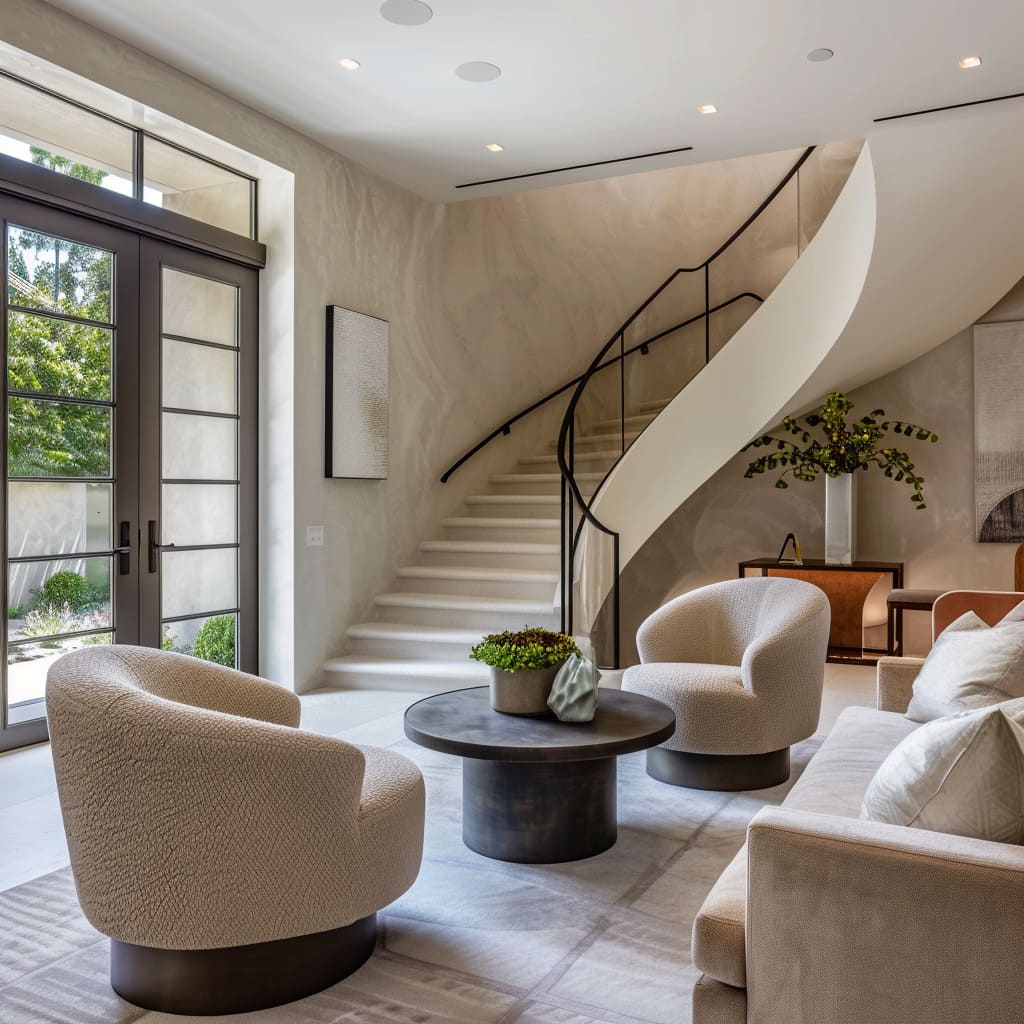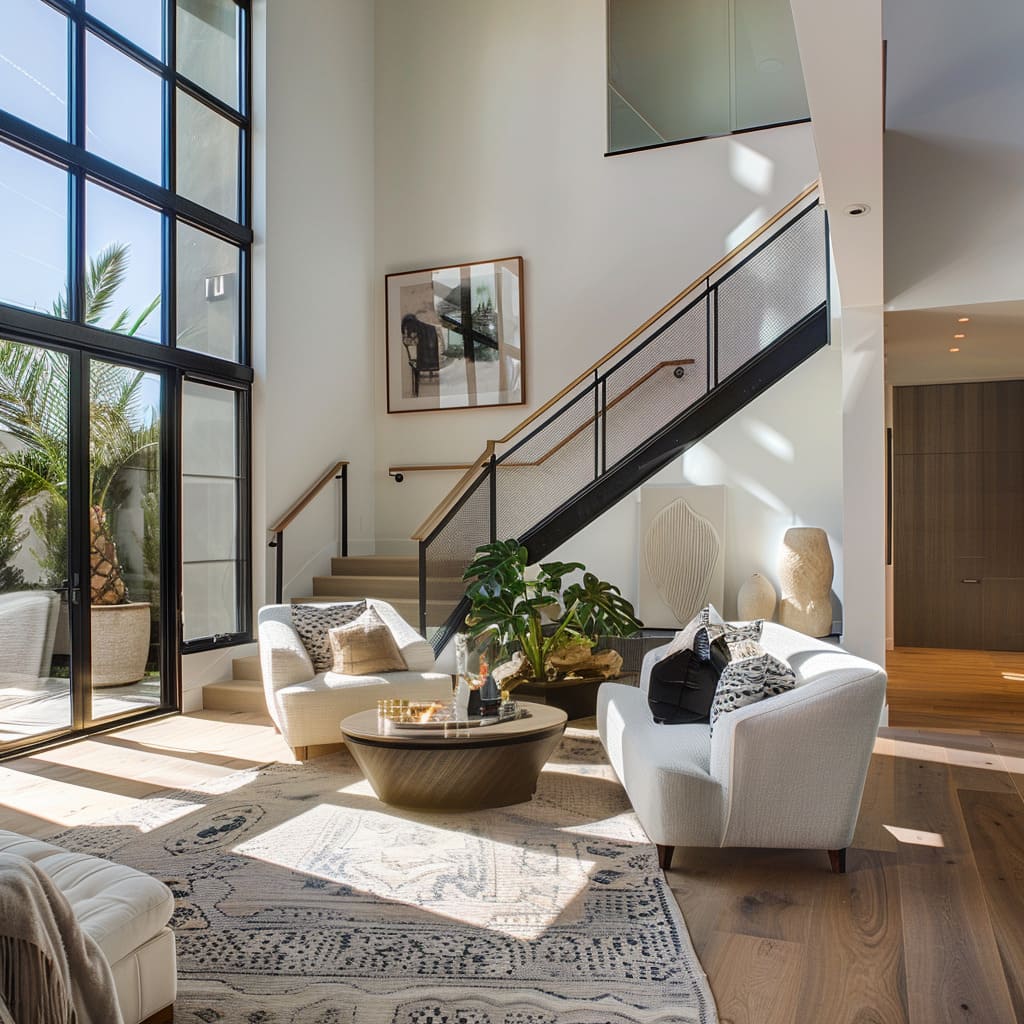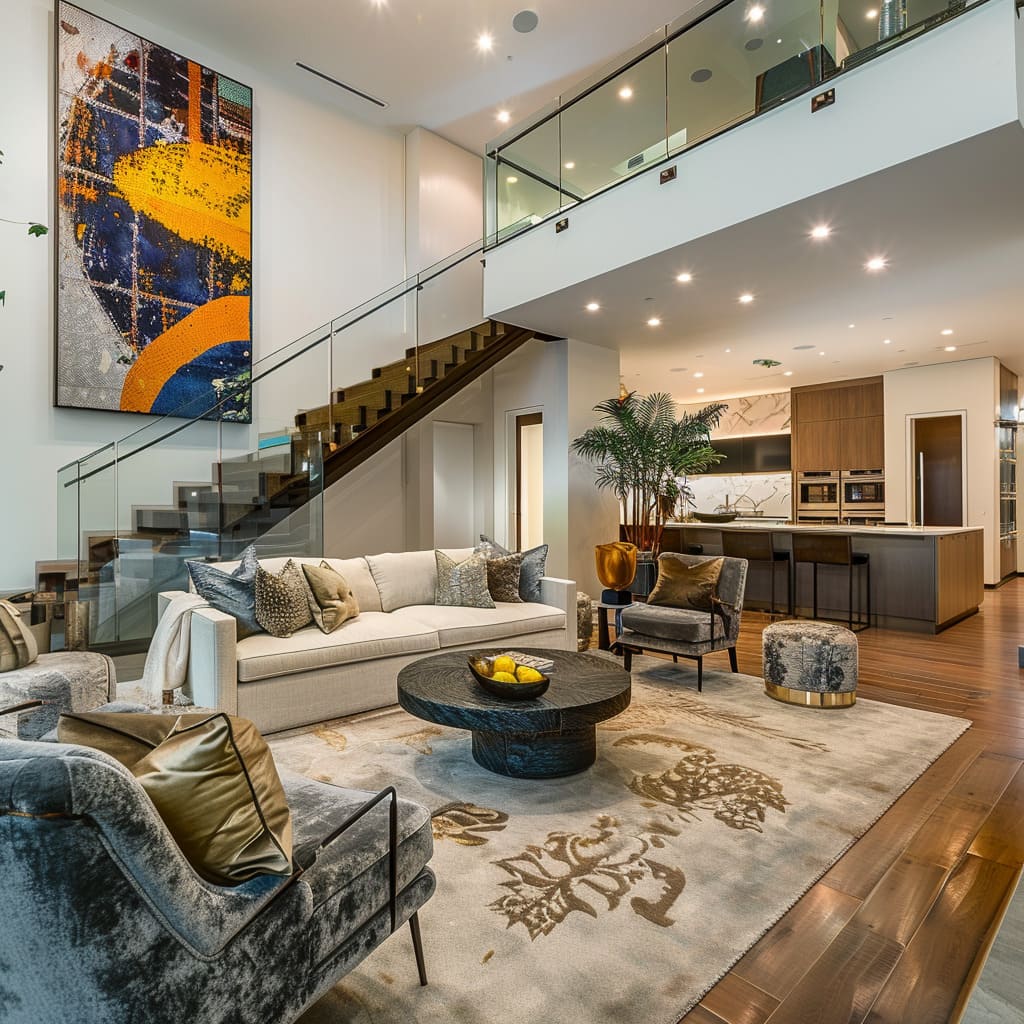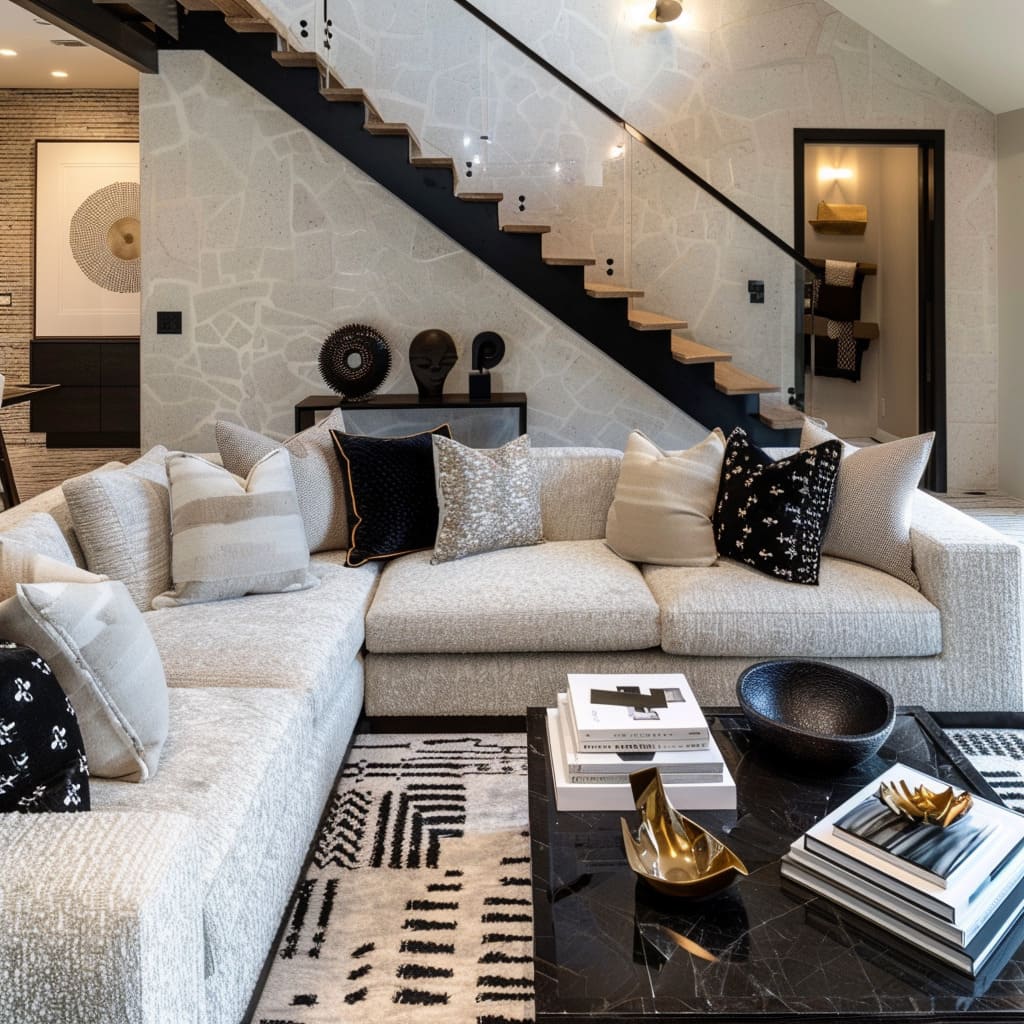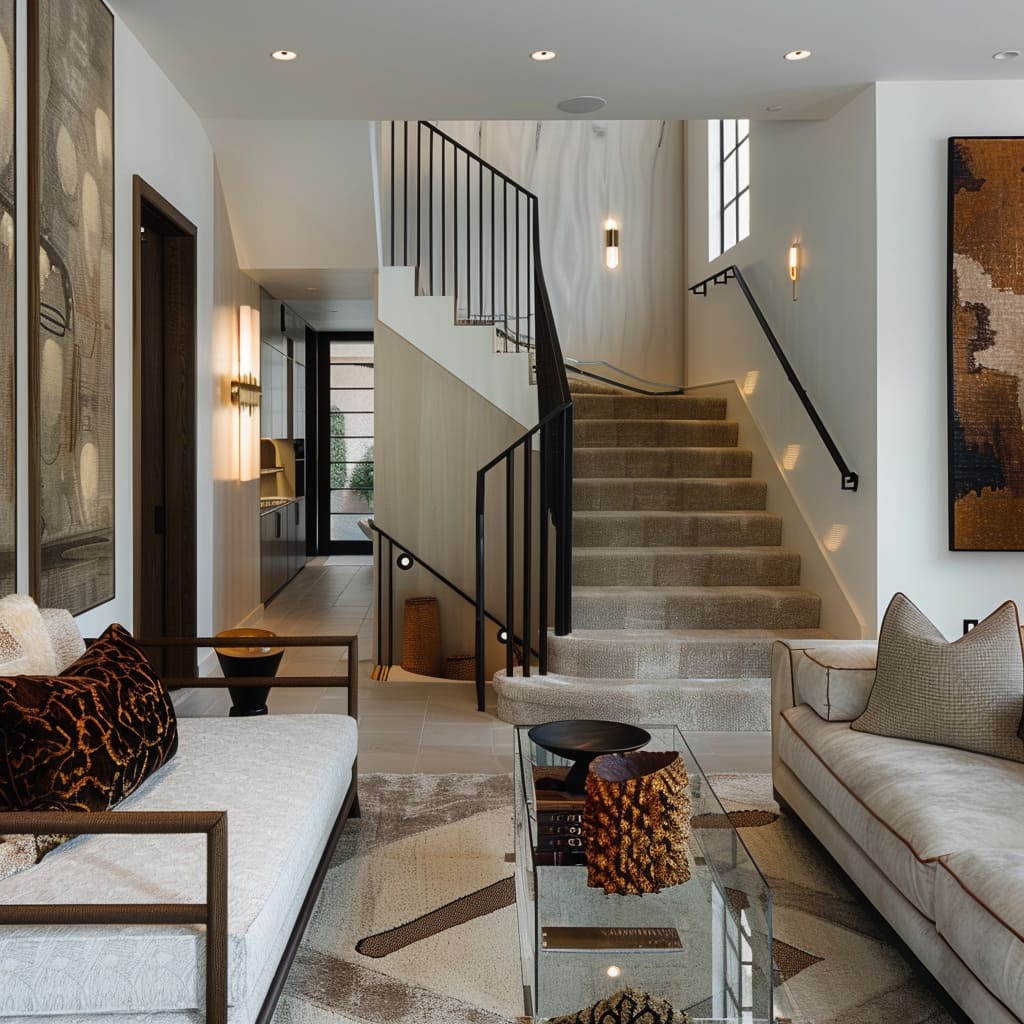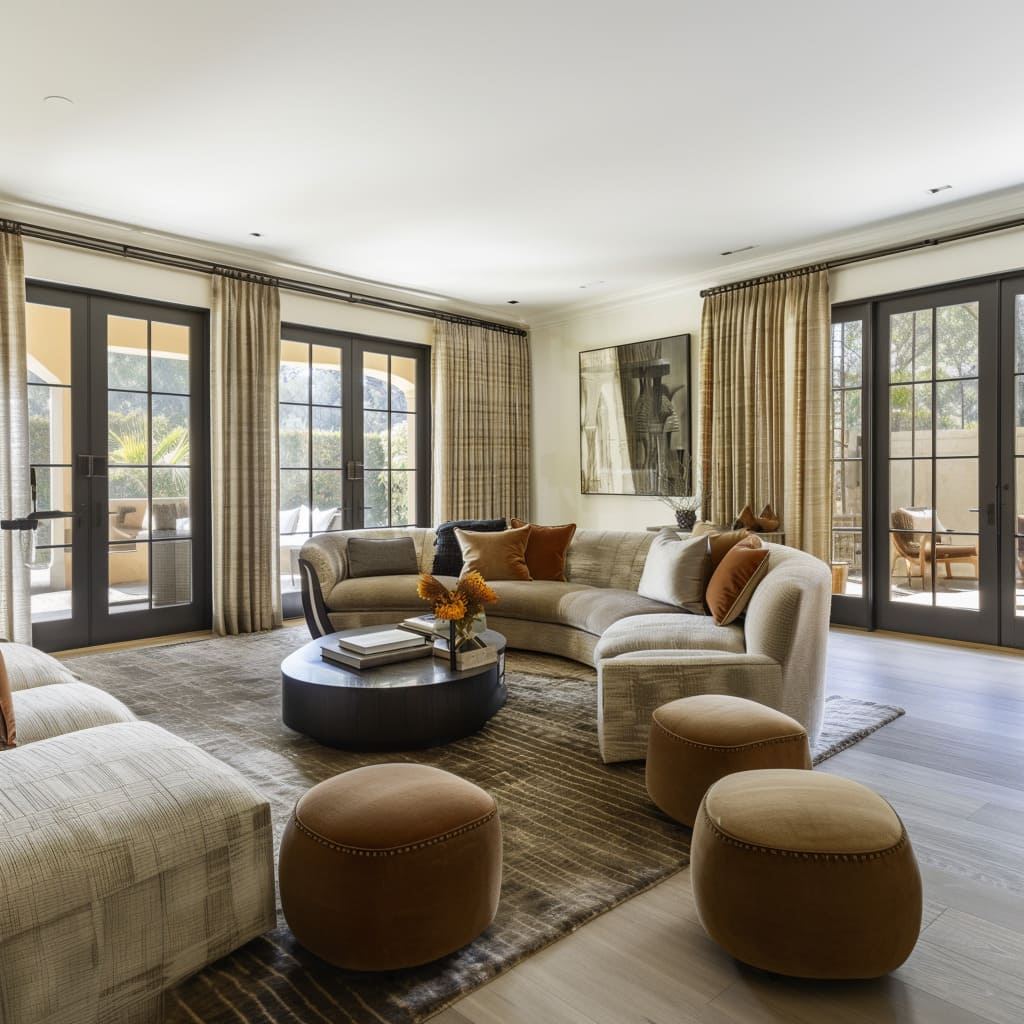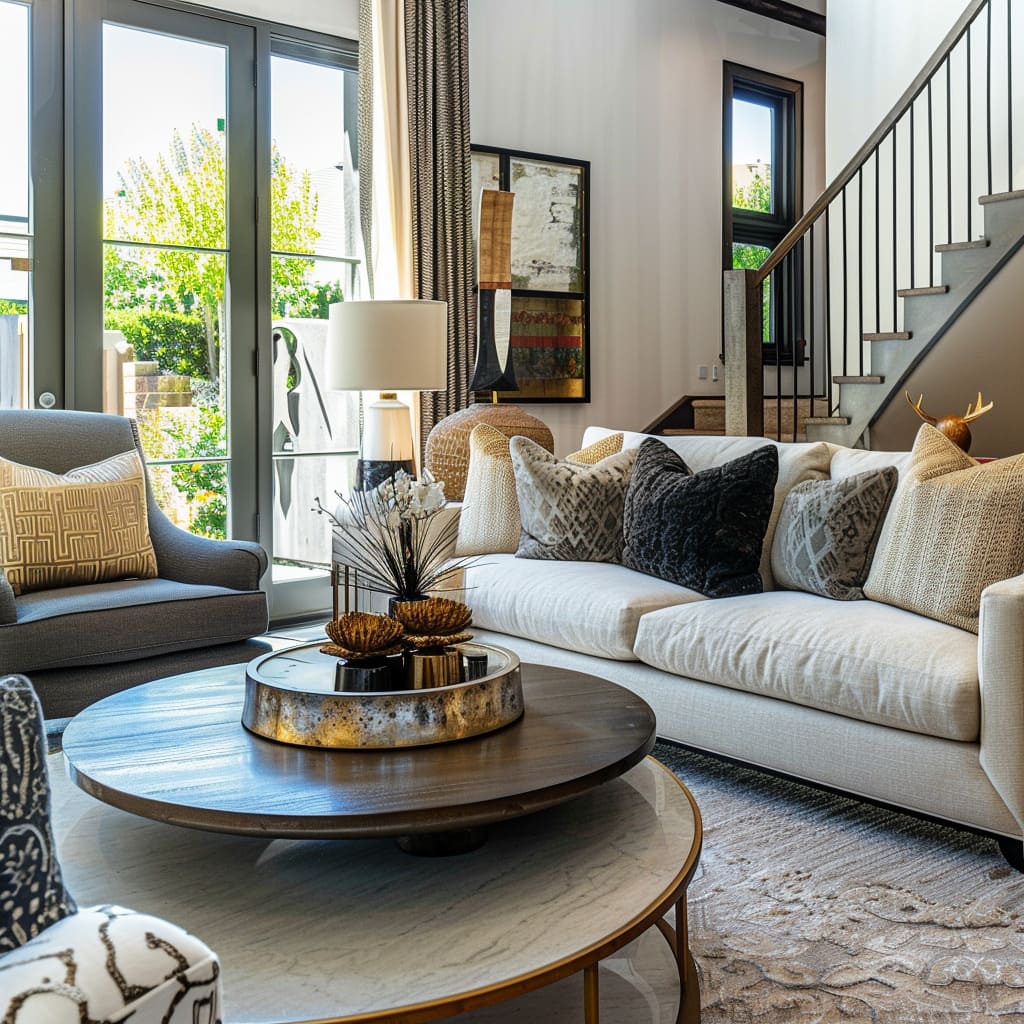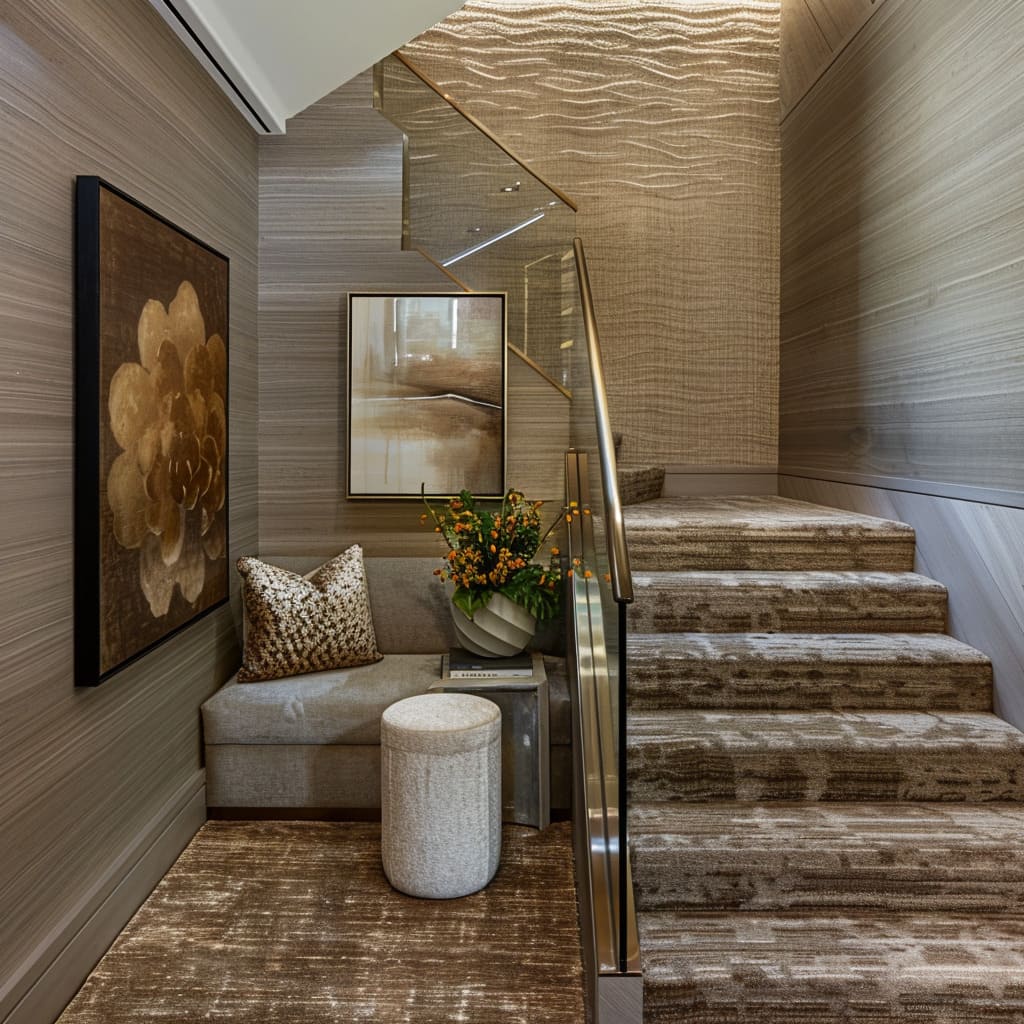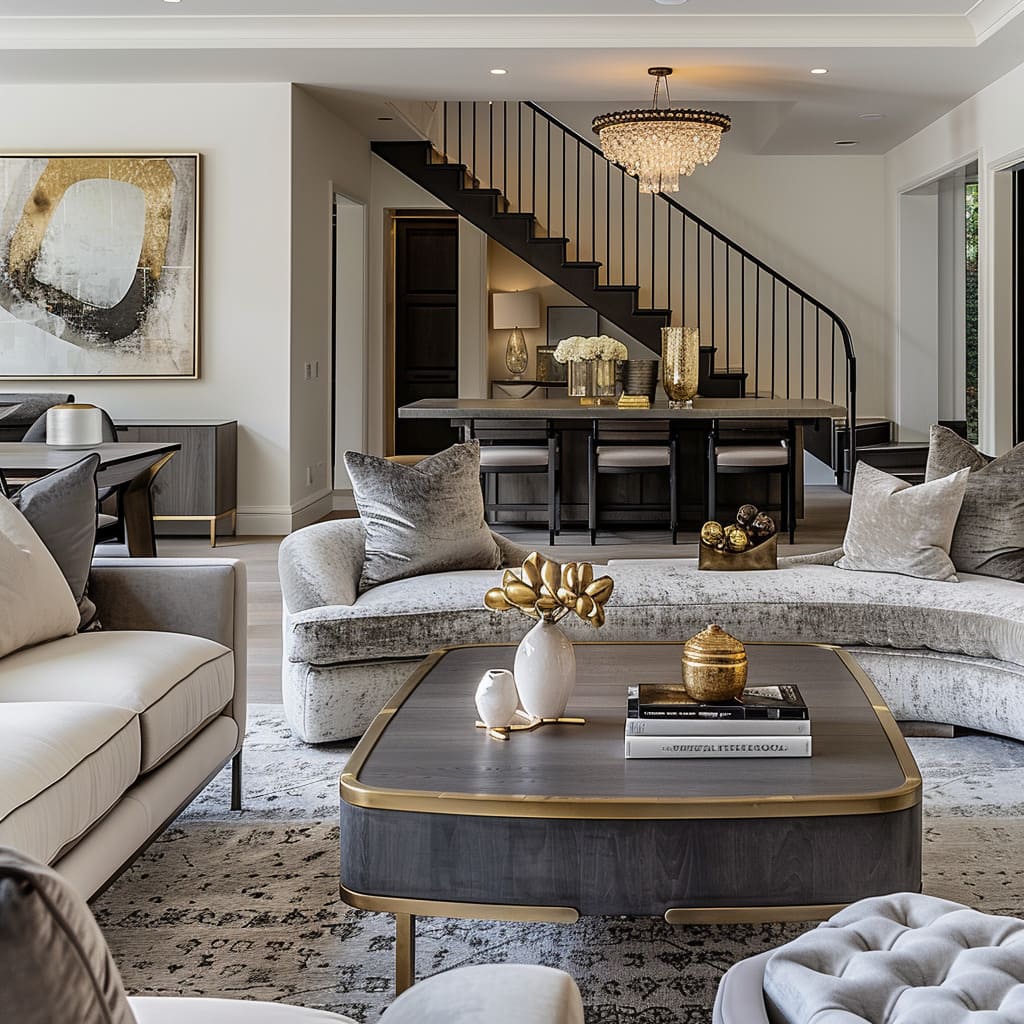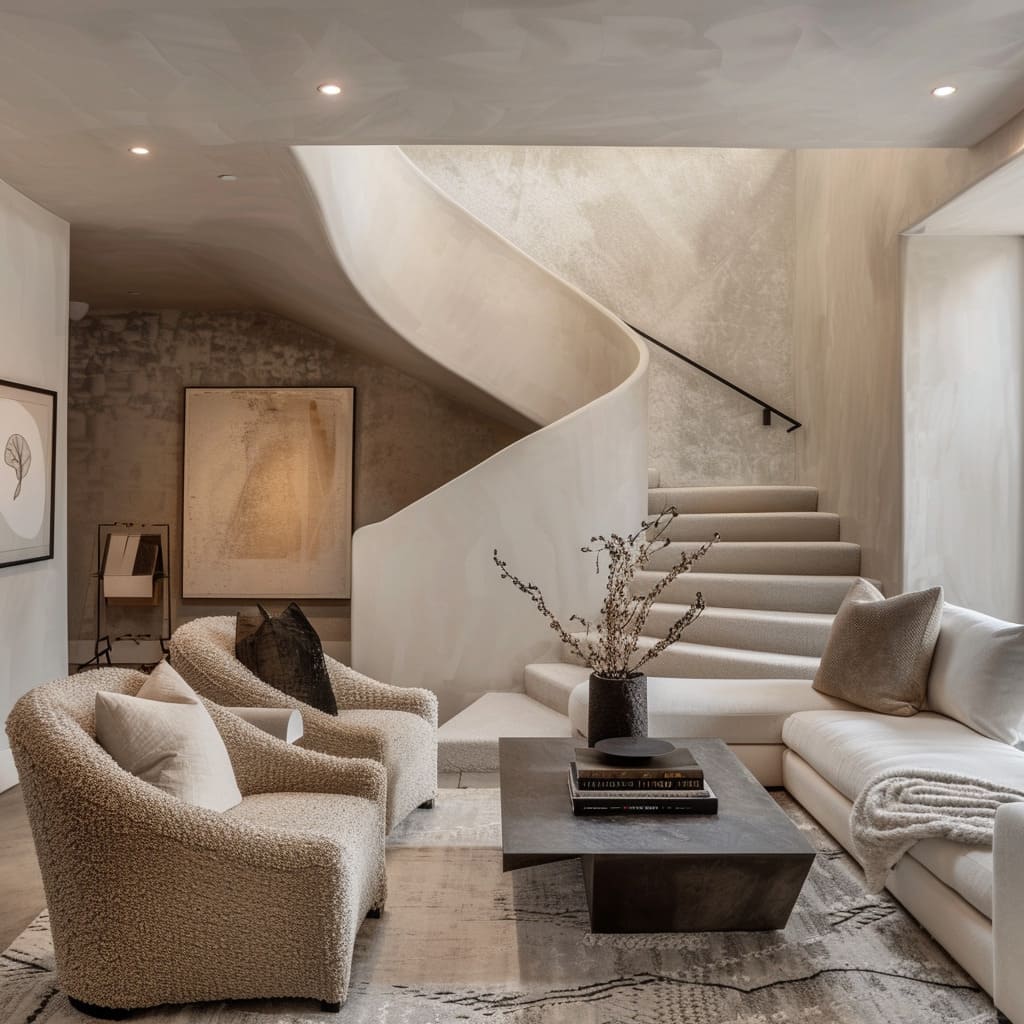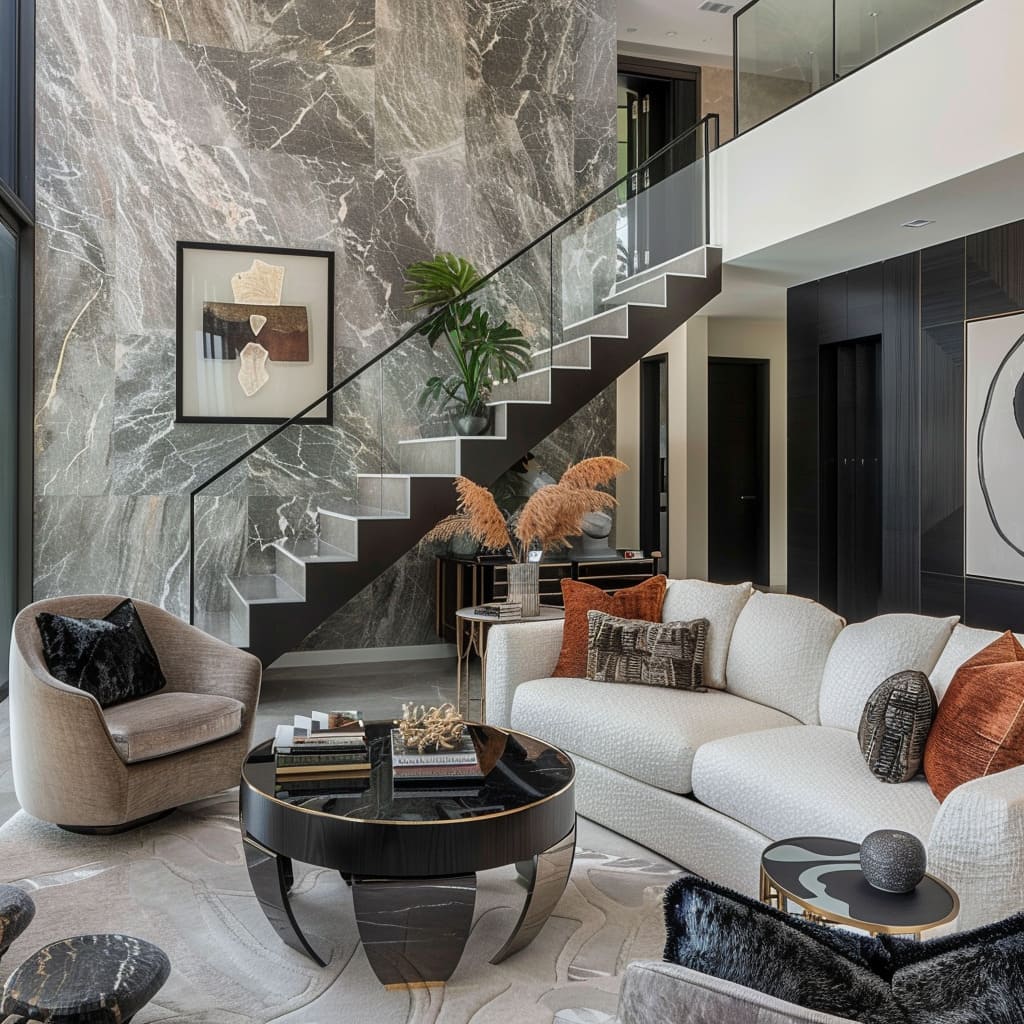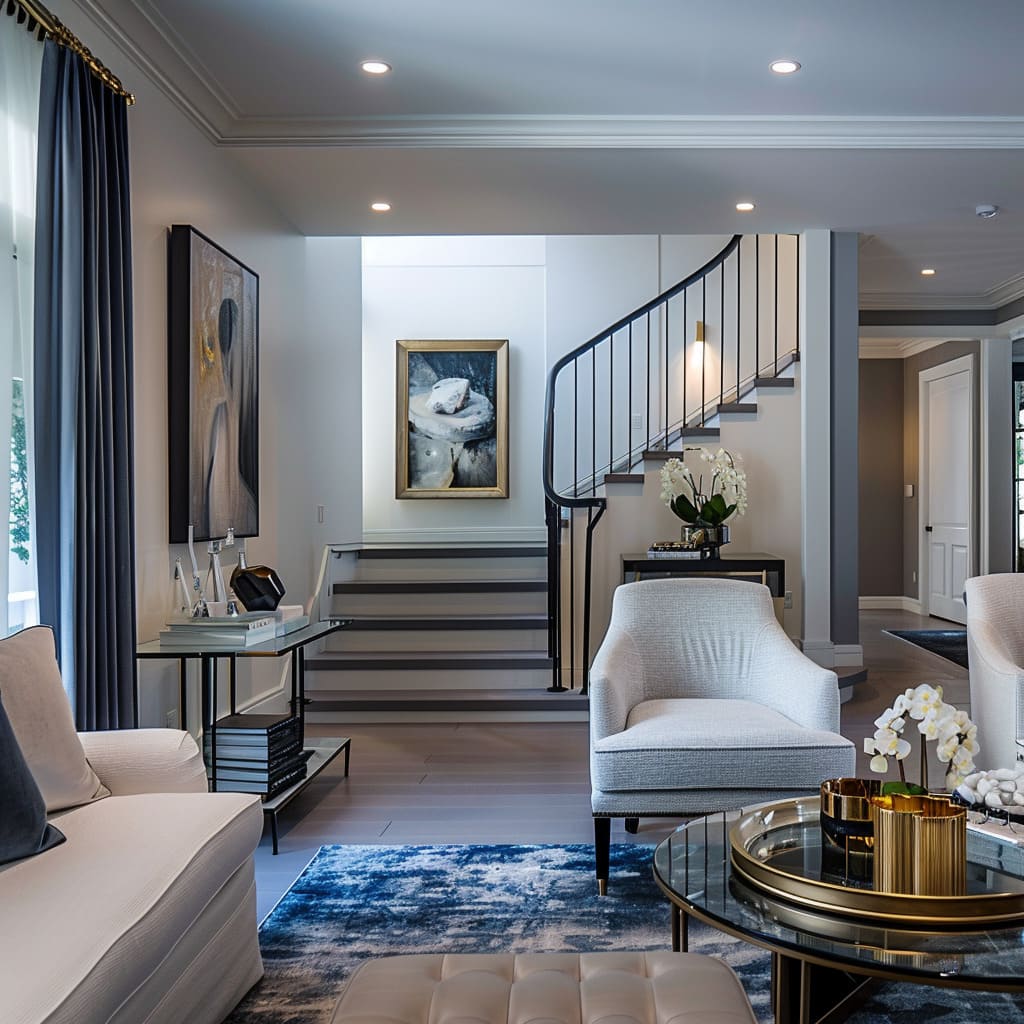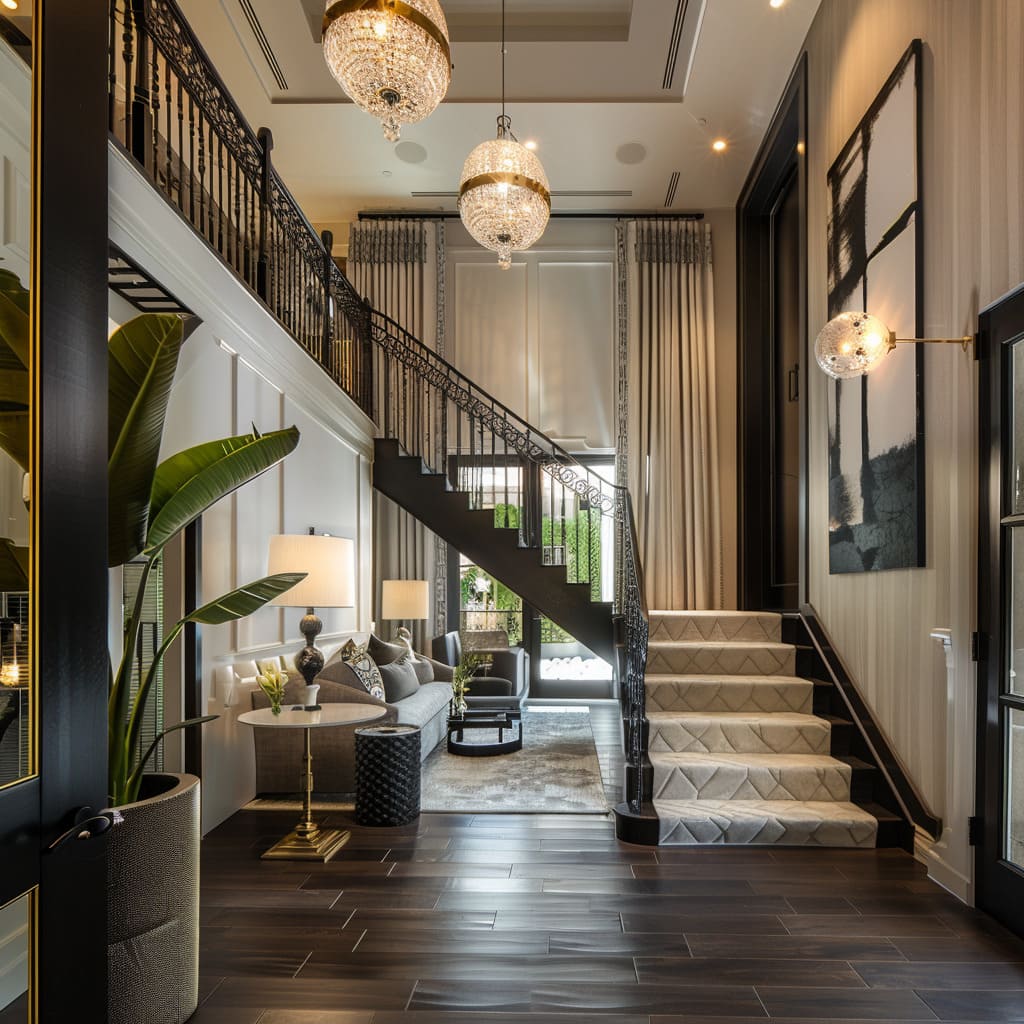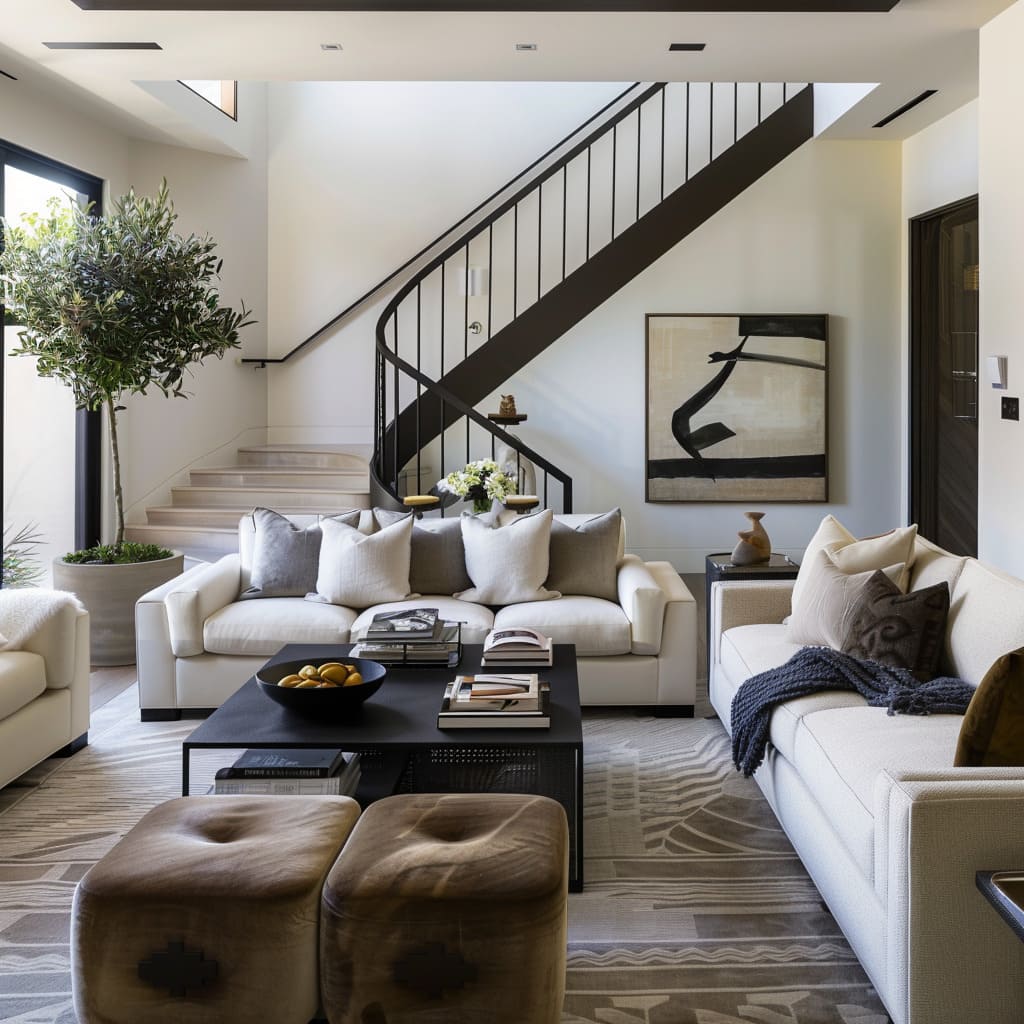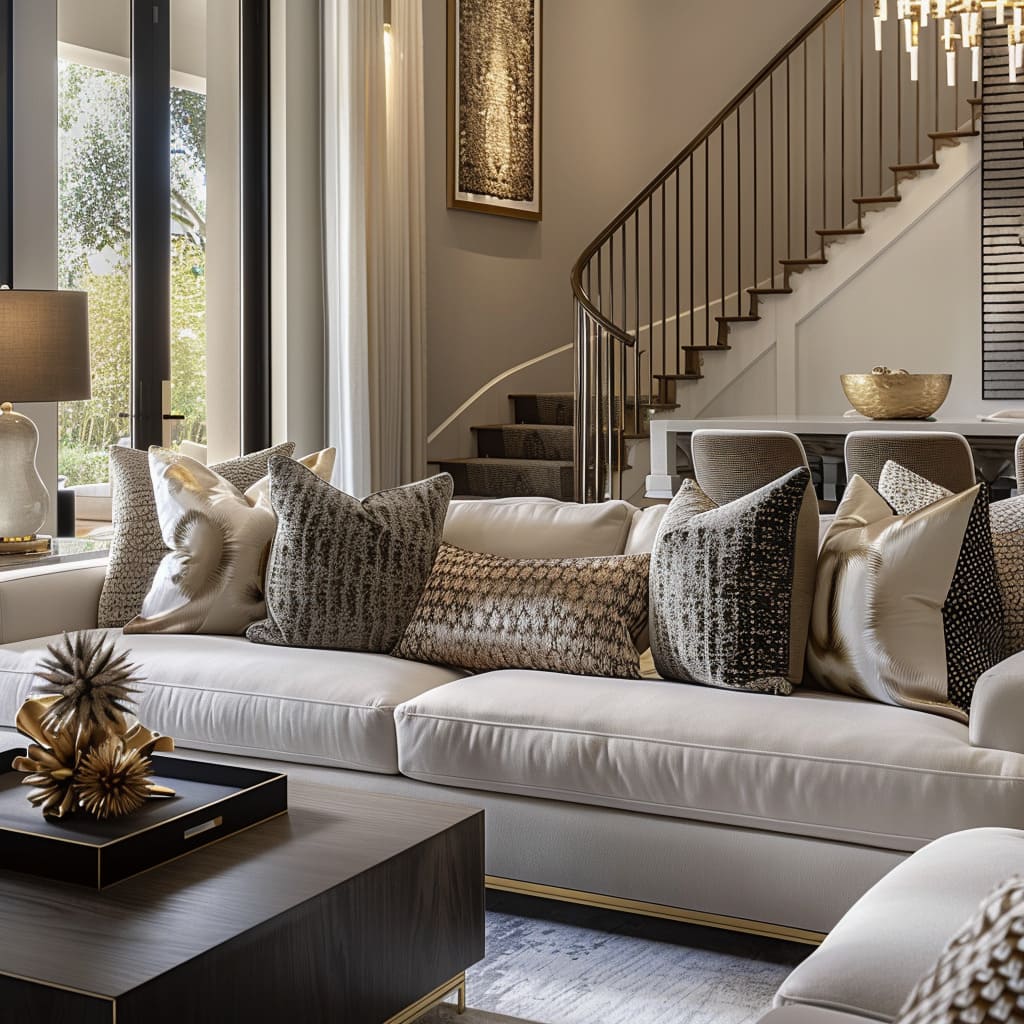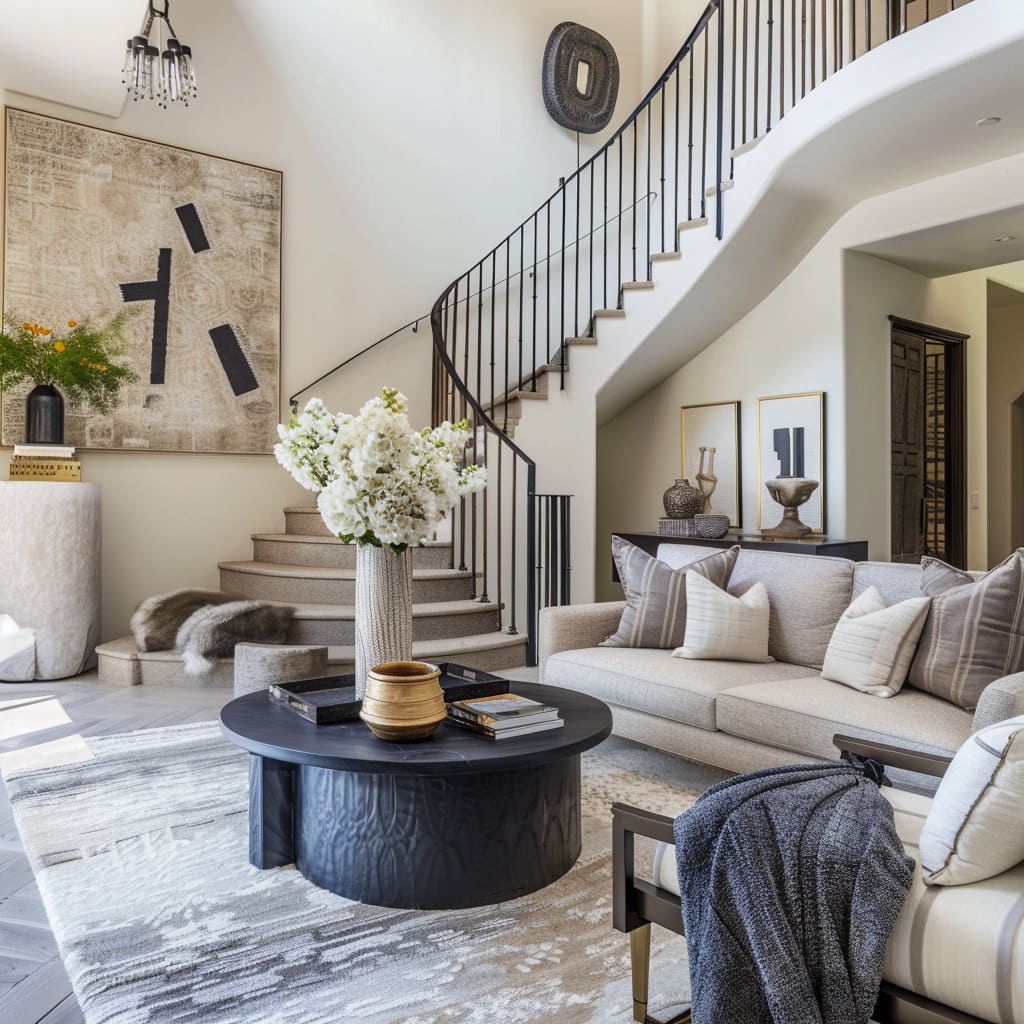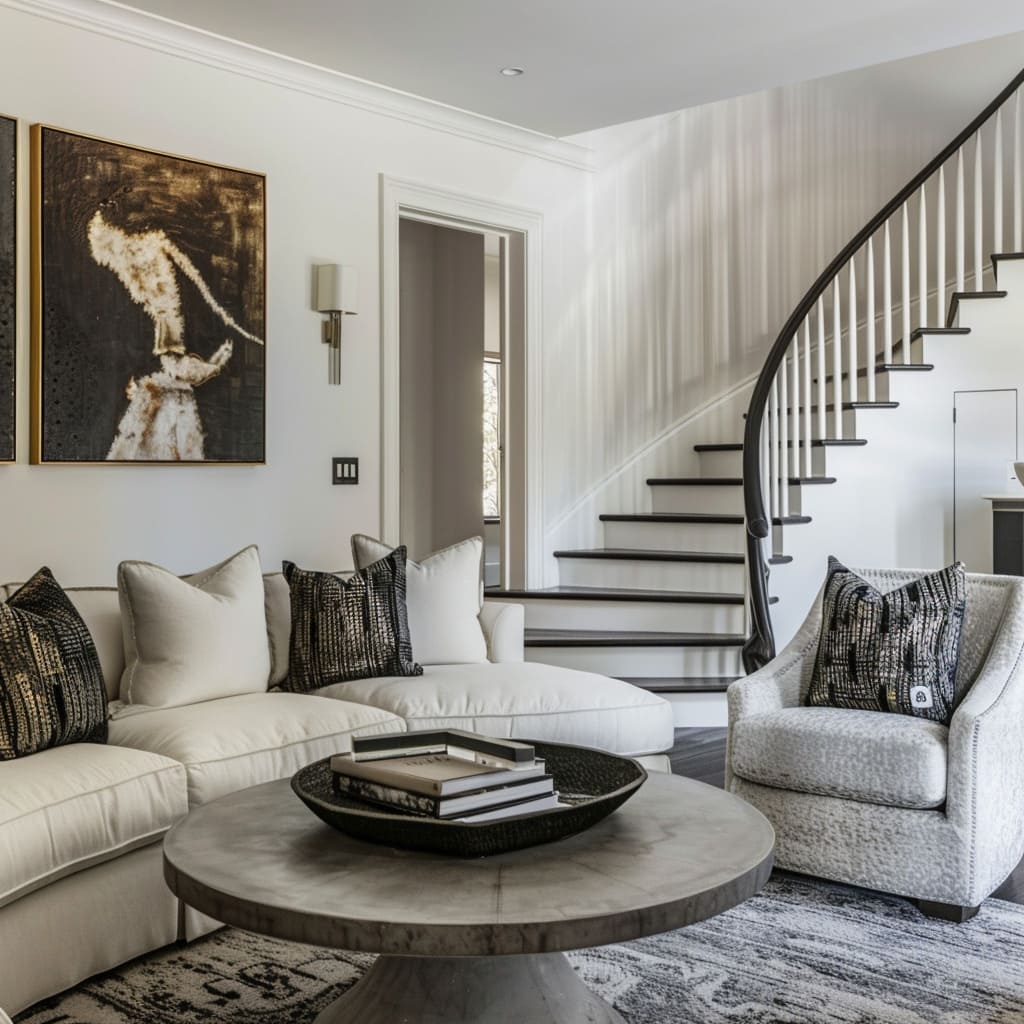Transforming living spaces into vibrant tapestries of form and function. This exploration delves into the essence of modern interiors, where each element—from the expansive ceilings to the interplay of shadows—collaborates to create environments that resonate with those who inhabit them.
Here, architecture and interior design converge, not just to create rooms, but to forge experiences that linger in the memory, inviting a deeper connection with our surroundings.
Architectural Expression
The art of architecture in interior design is not merely about the functional use of space but about telling a visual story. This narrative unfolds through dramatic ceilings that serve as a canvas, staircases that double as sculptural statements, and walls treated with diverse textures and materials to create a layered backdrop.
These elements work in concert to elevate the aesthetic dialogue between form and function.
Ceiling as a Canvas
In these designs, the ceiling transcends its traditional role to become a striking component of the space.
Through the incorporation of recessed lighting, the ceiling offers a soft luminescence that complements the natural lighting, while varying heights create an architectural rhythm that speaks to both the heart and mind. This layered approach to the ceiling’s design introduces a sense of grandeur and expansiveness that encourages the onlooker to linger on the details above.
Wall Treatments
The walls stand as testament to creativity, where wood paneling imbues the space with warmth, stone adds rustic or sleek elegance depending on its finish, and wallpaper introduces patterns that provide subtle visual stimuli. This treatment is an homage to the tactile and visual experiences that are essential in creating a space that is not only seen but felt, inviting a deeper interaction between the environment and its inhabitants.
Staircase as a Focal Point
As a pivotal design element, the staircase does more than connect floors; it bridges the gap between mere necessity and aesthetic spectacle. The bold use of materials, from polished metal to richly stained wood, combined with innovative designs, transform these staircases into vibrant centerpieces.
They serve as both conduit and conversation piece, inspiring awe and elevating the act of movement to an art form.
Staircase as a Sculpture
Here, the staircase becomes a stand-alone piece of art.
Its design, be it a spiral ascendancy or an angular descent, showcases a fluidity that contradicts its solid construction. The interplay of light and shadow cast by the steps, railings, and spindles adds a dynamic visual element that shifts with the day, ensuring the staircase remains a source of perpetual fascination.
Varied Ceiling Heights
The strategic manipulation of ceiling heights serves not only to define spaces within an open plan but also to alter the experiential quality of each zone. Lower ceilings foster intimacy and focus, while towering heights encourage a sense of freedom and possibility.
This deliberate design choice plays a key role in shaping the atmosphere of the interior, offering subtle cues that guide the emotional response of those within the space.
Learn about the evolution of modern architectural styles and how they influence today’s urban landscapes by visiting our detailed guide.
Design as a Visual Language
In these spaces, design elements go beyond mere utility to serve as a visual language. Dynamic shapes, creative color blocking, and purposeful asymmetry articulate a contemporary vocabulary, while modular design elements and zoning with rugs provide a flexible syntax that adapts to the narrative of daily living.
Furniture as Art
Each piece of furniture is chosen not just to fill space but to make a statement. Armchairs and sofas are adorned with fabrics that beg a second glance, while tables and cabinets echo the aesthetics of modern sculpture.
This intentional selection ensures that the practical becomes the beautiful, with every item inviting contemplation and conversation, blurring the lines between utility and artistry.
Creative Color Blocking
Strategic use of color enhances spatial understanding, segments rooms without physical barriers, and infuses the area with vitality. In this manner, color becomes a tool for shaping perceptions, delineating functions within a space, and creating a visual journey that is both intuitive and surprising.
It’s not merely about adding color but about composing a narrative with hues that shift seamlessly from one to the next.
Dynamic Shapes
The contours of the furniture and built elements defy expectation; soft, organic curves meet the eye where one would expect straight lines, and sharp angles provide counterpoints to traditional forms. This use of shape demonstrates a boldness of vision, an understanding that the structures we live among can reflect the fluidity and complexity of life itself.
Purposeful Asymmetry
In a deft departure from the ordinary, asymmetry is employed to captivating effect. Lighting fixtures hang with an intentional imbalance, and furniture is arranged to create visual tension and interest.
This deliberate choice adds a layer of sophistication to the space, encouraging a deeper engagement as the eye seeks to find balance within the deliberate irregularity.
Modular Design Elements
The flexibility of the environment is paramount, where modular components allow for a living space that adapts and changes according to the needs of the moment. Seating can be reconfigured for social gatherings or solitary relaxation, and storage components can be rearranged to alter both the function and the form of the room.
Zoning with Rugs
In the vast canvas of the floor, rugs serve as defining strokes, setting apart lounging areas from dining spaces or entryways. The textures and patterns of these rugs add a layer of depth, while their placement is a subtle cue, guiding foot traffic and providing islands of function in a sea of open space.
Sensory and Material Richness
A profound understanding of materials and textures imparts a tactile richness to these interiors. The interplay of textures and innovative material use creates an environment that invites touch, while mature plant life and whimsical elements introduce organic and playful notes, respectively, engaging the senses on multiple levels.
Textural Interplay
This design philosophy champions the sensory appeal of textures. It encourages the hands to explore and the eyes to appreciate the contrast between the smoothness of polished stone and the rugged allure of textured fabrics.
This tactile diversity is carefully orchestrated to provide a physical experience of luxury and comfort, ensuring that the environment is as pleasing to the touch as it is to the eye.
Innovative Material Use
There is a boldness in the selection and application of materials, where common expectations are defied. Handrails become statements of style as much as safety when wrapped in rich leather, and walls are not merely partitions but canvases for expression, clad in stones that tell tales of the earth’s deep history.
These choices reflect a commitment to using materials not only for their innate beauty but also for their ability to surprise and captivate.
Mature Plant Life
Flora plays a significant role, with mature, lush plants bringing a sense of the outside world into the heart of the home. These living elements are not mere afterthoughts but integral components of the design, chosen for their sculptural forms and the robust vitality they lend to their surroundings.
They create an atmosphere of growth and natural elegance, reminding occupants of the ever-present link between human creation and the natural world.
Whimsical Elements
The incorporation of whimsy introduces a light-hearted break from the seriousness of design. It might be found in the unexpected placement of a playful sculpture, the quirky shape of a light fixture, or a piece of art that challenges perceptions.
These elements serve as a reminder that design is not just a science but also an art, one that allows for moments of joy and personal expression.
Each detail is a note in the symphony of the space, playing its part to create a richer, more immersive experience. Together, they form an environment that speaks to both the spirit and the senses, inviting those within to not just occupy the space but to feel it, connect with it, and live it fully.
The Light and Shadow Play
Light in these interiors is not just for visibility but a central feature of design that shapes the mood and highlights the artistry within. Climactic lighting fixtures, subdued color transitions, and purposeful art lighting converge to create a play of light and shadow, offering illumination that is both functional and dramatic.
Climactic Lighting Fixtures
Lighting fixtures are selected not merely for their luminous output but for their visual impact, anchoring spaces with their bold designs. They drape the room in washes of light that can shift from the vibrant clarity of daylight to the subdued whisper of twilight.
These fixtures are often positioned as the crowning feature of a room, offering a radiant spectacle that interacts with the hues and textures around them, lending an almost theatrical quality to everyday living.
Subdued Color Transitions
In this thoughtful approach to color, the transitions are crafted with a gentle hand, encouraging the eye to move smoothly across the space. These gradients mirror the subtle shifts of the natural world, from the blush of dawn to the soft glow of dusk.
The choice of colors speaks to a preference for understatement, where the visual volume is tuned to a level that soothes rather than startles, creating an aura of serenity.
Purposeful Art Lighting
Artwork is not left to fend for itself in the ambient glow of a room; it is celebrated with lighting that enhances its colors and shapes, bringing every brushstroke and contour to vivid life. This intentional illumination transforms paintings and sculptures into focal points that command attention, ensuring that the art shares a symbiotic relationship with the space it inhabits, neither overshadowed nor overwhelming.
Varied Lighting Dynamics
The interplay between light and shadow is meticulously arranged to add depth and dimension. Fixtures are placed to cast a cascade of shadows where desired, creating a living mural that evolves with the passing hours.
In this way, the interaction of light with the furnishings and architectural elements becomes an ever-changing display, reflecting the passage of time in a visual language.
Ambient and Accent Lighting
Beyond the primary fixtures, ambient lighting subtly fills the room with a soft glow, while accent lighting punctuates the space, drawing attention to the textures and features that might otherwise go unnoticed. The combined effect is a stratified approach to lighting that complements the natural rhythms of daily life, providing for every activity, from the focus required for work to the relaxation that comes with rest.
Integrated Lighting Solutions
Lights are often built directly into the architecture itself, with strips and spots hidden within recesses and alcoves. This integration allows the light to emerge as if from the structure itself, providing a clean look that maintains the sleek lines of the design without the interruption of protruding fixtures.
Controlled Luminance
With the advent of smart home technology, the intensity and color of light can be adjusted with precision, allowing occupants to curate their environment to match their mood or the task at hand. It is a level of control that transforms light from a static background feature to an active participant in the home’s ambiance.
Natural Light as a Companion
Alongside the artificial, natural light is harnessed through expansive windows and skylights. During the day, it plays a leading role, while at night, the man-made lights take precedence, ensuring that the beauty of the space is always displayed to its best advantage, by day or by night.
Visual and Acoustic Harmony
The curation of views and the careful consideration of acoustics are essential to achieving a harmonious environment. By employing selective transparency and acoustic considerations, these designs create spaces that are not only visually pleasing but also maintain a serene auditory atmosphere.
Selective Exposure
In the artful arrangement of interiors, there are spaces where the eye is encouraged to explore beyond the immediate. Glass partitions and open shelving are not mere structural necessities but deliberate design choices, offering glimpses into adjoining areas.
This creates a layered experience of discovery, where each glance through a transparent barrier invites curiosity and subtly connects the separated zones.
Selective Transparency
Glass is employed not just as a barrier but as a visual bridge, its transparency fostering a sense of continuity between spaces. In stair railings and room dividers, glass serves to both open up the interiors and define them, marrying the concepts of division and unification.
It allows for an abundance of natural light to permeate throughout, enhancing both the perceived and actual size of the areas.
Acoustic Considerations
The harmony of a space is as much about sound as it is about sight. Soft furnishings absorb and muffle sound, contributing to a serene atmosphere where the hustle of the external world fades into tranquility.
These materials are chosen for their ability to dampen noise, ensuring that peace prevails, and each room becomes a secluded retreat from the chaos of the everyday.
Curated Views
Windows and glass walls serve as meticulously placed frames, capturing the outdoor scenery as if it were art hung upon the walls. The selection and sizing of these views are as thoughtful as the placement of a painting, designed to include the outdoors as an integral part of the interior landscape.
The effect is a dynamic visual dialogue between the built environment and the natural one.
Visual Rhythm Through Transparency
The visual rhythm of a space is punctuated by elements of transparency that create a cadence of sightlines. This rhythm is carefully composed, ensuring that the eye moves with ease from the intimacy of enclosed spaces to the liberating sweep of open vistas, creating a dynamic that is both comforting and engaging.
Integrated Aesthetics and Function
These spaces are defined by an aesthetic sensibility that seamlessly integrates with functionality. Subtle details like intricate molding and staircase materials echo the broader design scheme, while discrete technology integration ensures modern convenience without compromising the visual flow.
Integrated Art Niches
In the seamless integration of art within living spaces, niches carved into walls serve as sanctuaries for artistic expression. They are not arbitrary recesses but are as much a part of the architectural design as the walls themselves, shaped and positioned to honor the artwork they house.
These alcoves subtly command attention, giving art its due prominence while maintaining the fluidity of the interior’s design narrative.
Color Punctuation
Within a carefully composed monochromatic scheme, bursts of color act as visual exclamation points. These deliberate splashes provide a dynamic break in the continuity, drawing the eye and enlivening the space.
These are not random; they are thoughtful insertions that resonate with the room’s accent pieces, creating a dialogue between the elements.
Staircase Materials as Accents
The staircases, often bold in design, carry on the conversation of materials found throughout the home. A wooden rail might echo the warm hues of a living room’s hardwood floor, while a metallic finish can reflect the cool sheen of modern kitchen appliances.
These material choices forge a cohesive design language that speaks to both the unity and the utility of the space.
Intricate Molding
Moldings act as the refined borders of a space, tracing ceilings and walls with a subtle grace. Their designs, whether simple or elaborate, bring a depth of character to the rooms, accentuating heights and widths, and framing the areas as a painter’s frame enhances a canvas.
Yet, this ornamentation is restrained, ensuring that the sophistication it brings is never at odds with the calm of the environment.
Discrete Technology Integration
The modern home’s functionalities are woven into the fabric of its design. Outlets, switches, and home automation controls are placed with consideration, maintaining the aesthetic integrity of the space.
Technology serves silently and invisibly, providing comfort and convenience without demanding visual attention, ensuring that the design’s purity remains undisturbed.
Dynamic Flow and Movement
The flow of movement within a space can create a subliminal guide to experiencing the environment. These interiors are designed with the intent to guide occupants effortlessly from one area to the next, with elements of design directing the pace and direction of movement.
Flow of Movement
Interiors are orchestrated to facilitate a natural progression from space to space, encouraging a fluid motion that aligns with the daily rhythms of life. Furniture is placed not only to enhance the functionality of each room but also to suggest pathways that lead effortlessly into the next.
The spaces invite exploration without directing it, allowing for an organic discovery of each room’s purpose and charm.
Visual Continuity
Cohesion is key in these spaces, with flooring materials extending like a continuous thread that weaves through the tapestry of rooms, unifying diverse areas into a single narrative. Color schemes follow suit, with a carefully curated palette that transitions subtly from one environment to the next, fostering a sense of unity that holds the design together.
As we conclude this exploration of thoughtfully designed spaces, we’re reminded of the profound influence that such environments have on our daily experiences. The balance between aesthetics and utility, the thoughtful arrangement of textures and lights, and the guiding flow of space all converge to define more than just a place to live—they define a place to thrive.
These spaces stand as a testament to the vision and dedication of their creators, offering more than shelter but a canvas that continuously shapes and reflects our lives. Through this intricate dance of design, we’re invited to not just observe but to interact, to make these spaces our own, and to find our place within their carefully crafted dimensions.


